Origins of the universe, explained
The most popular theory of our universe's origin centers on a cosmic cataclysm unmatched in all of history—the big bang.
The best-supported theory of our universe's origin centers on an event known as the big bang. This theory was born of the observation that other galaxies are moving away from our own at great speed in all directions, as if they had all been propelled by an ancient explosive force.
A Belgian priest named Georges Lemaître first suggested the big bang theory in the 1920s, when he theorized that the universe began from a single primordial atom. The idea received major boosts from Edwin Hubble's observations that galaxies are speeding away from us in all directions, as well as from the 1960s discovery of cosmic microwave radiation—interpreted as echoes of the big bang—by Arno Penzias and Robert Wilson.
Further work has helped clarify the big bang's tempo. Here’s the theory: In the first 10^-43 seconds of its existence, the universe was very compact, less than a million billion billionth the size of a single atom. It's thought that at such an incomprehensibly dense, energetic state, the four fundamental forces—gravity, electromagnetism, and the strong and weak nuclear forces—were forged into a single force, but our current theories haven't yet figured out how a single, unified force would work. To pull this off, we'd need to know how gravity works on the subatomic scale, but we currently don't.
It's also thought that the extremely close quarters allowed the universe's very first particles to mix, mingle, and settle into roughly the same temperature. Then, in an unimaginably small fraction of a second, all that matter and energy expanded outward more or less evenly, with tiny variations provided by fluctuations on the quantum scale. That model of breakneck expansion, called inflation, may explain why the universe has such an even temperature and distribution of matter.
After inflation, the universe continued to expand but at a much slower rate. It's still unclear what exactly powered inflation.

Aftermath of cosmic inflation
As time passed and matter cooled, more diverse kinds of particles began to form, and they eventually condensed into the stars and galaxies of our present universe.
FREE BONUS ISSUE
By the time the universe was a billionth of a second old, the universe had cooled down enough for the four fundamental forces to separate from one another. The universe's fundamental particles also formed. It was still so hot, though, that these particles hadn't yet assembled into many of the subatomic particles we have today, such as the proton. As the universe kept expanding, this piping-hot primordial soup—called the quark-gluon plasma—continued to cool. Some particle colliders, such as CERN's Large Hadron Collider , are powerful enough to re-create the quark-gluon plasma.
Radiation in the early universe was so intense that colliding photons could form pairs of particles made of matter and antimatter, which is like regular matter in every way except with the opposite electrical charge. It's thought that the early universe contained equal amounts of matter and antimatter. But as the universe cooled, photons no longer packed enough punch to make matter-antimatter pairs. So like an extreme game of musical chairs, many particles of matter and antimatter paired off and annihilated one another.
You May Also Like
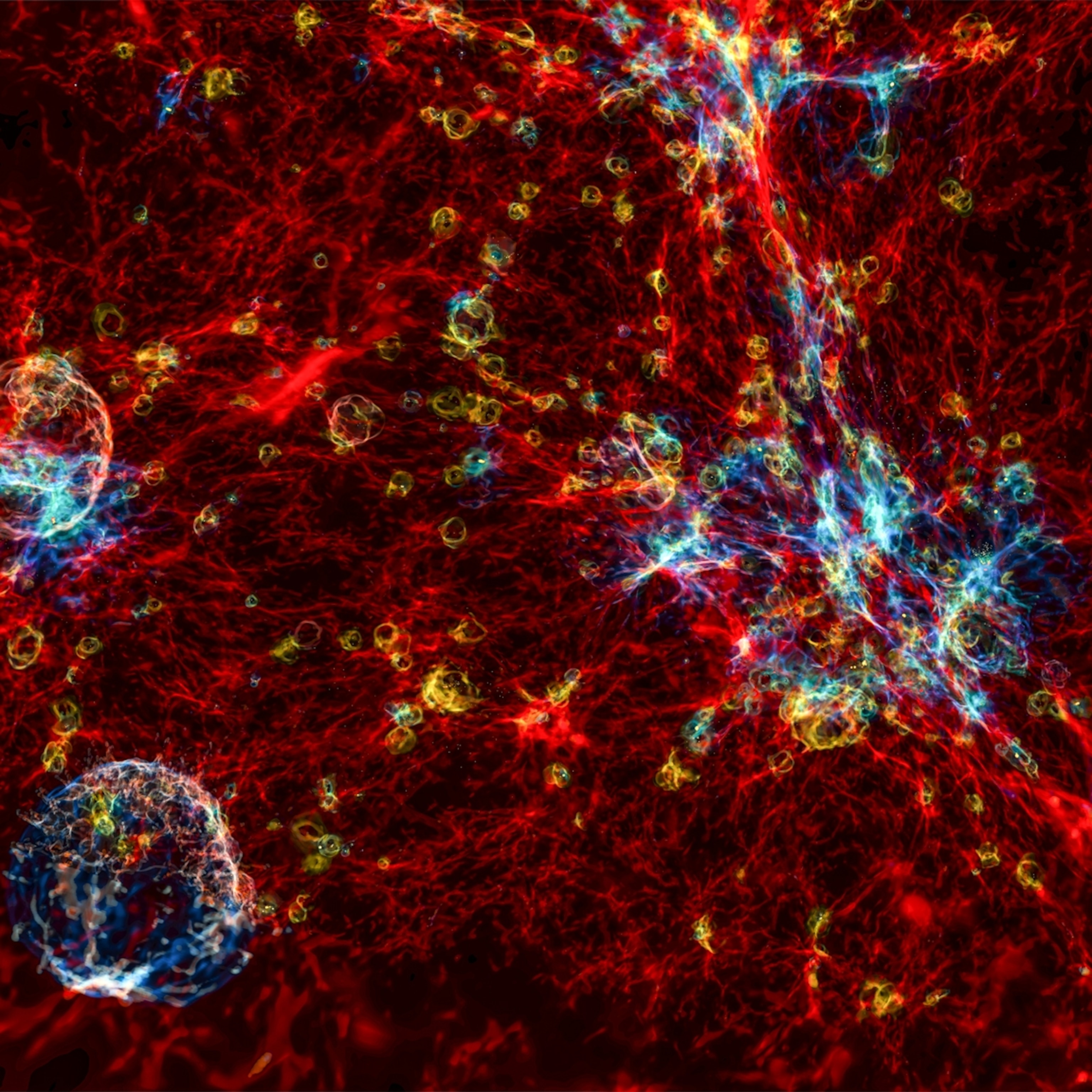
The world’s most powerful telescope is rewriting the story of space and time

How fast is the universe really expanding? The mystery deepens.
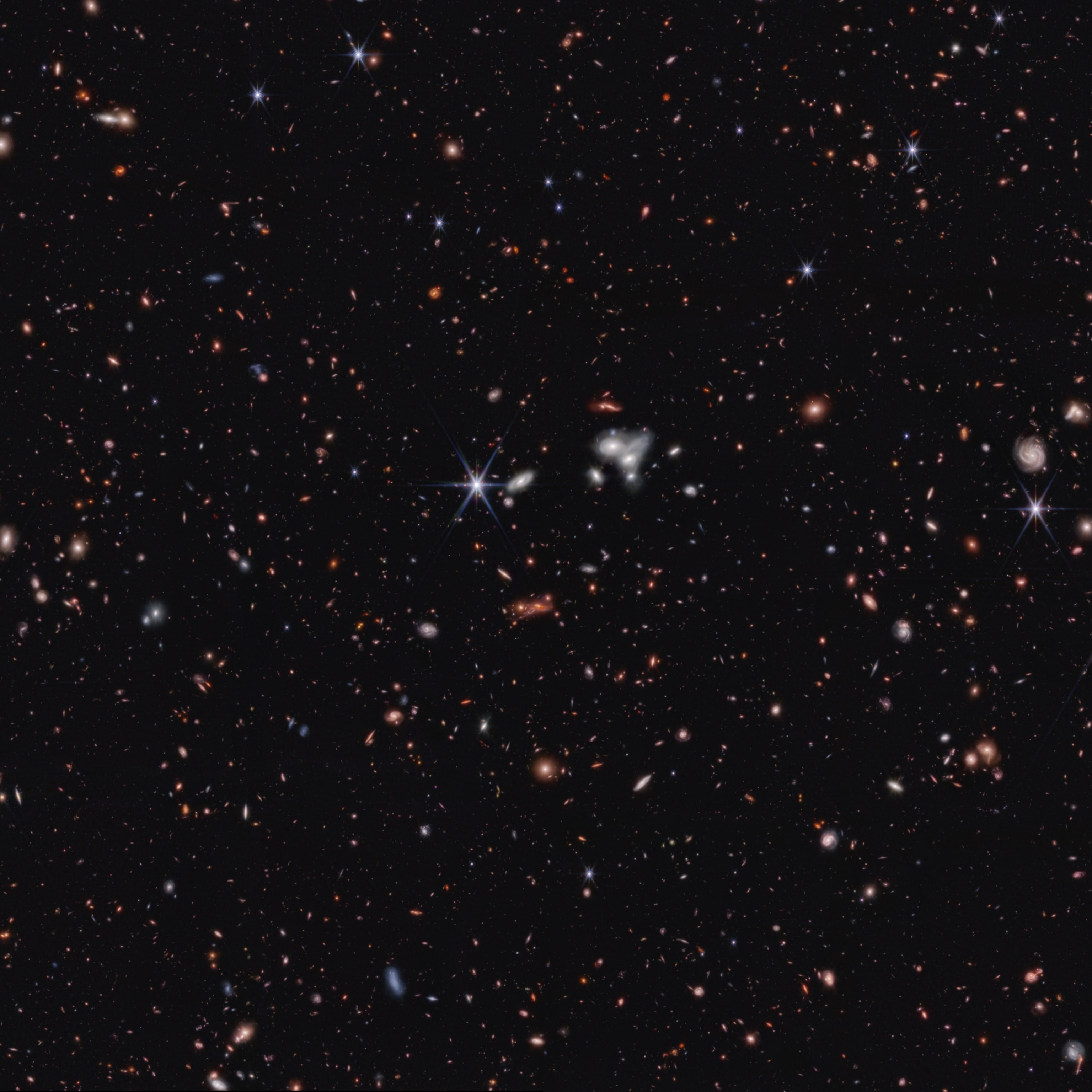
This supermassive black hole was formed when the universe was a toddler
Somehow, some excess matter survived—and it's now the stuff that people, planets, and galaxies are made of. Our existence is a clear sign that the laws of nature treat matter and antimatter slightly differently. Researchers have experimentally observed this rule imbalance, called CP violation , in action. Physicists are still trying to figure out exactly how matter won out in the early universe.
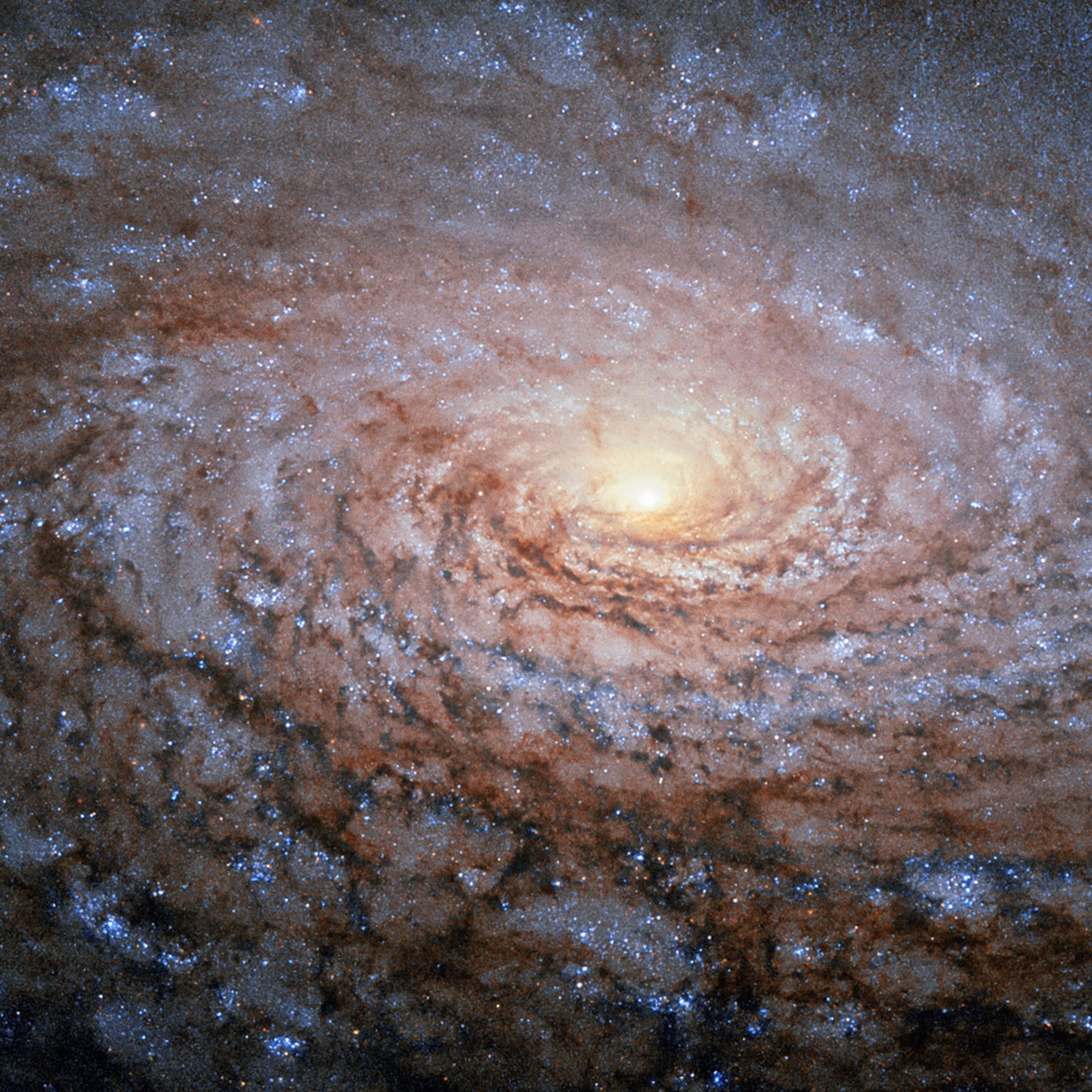
Building atoms
Within the universe's first second, it was cool enough for the remaining matter to coalesce into protons and neutrons, the familiar particles that make up atoms' nuclei. And after the first three minutes, the protons and neutrons had assembled into hydrogen and helium nuclei. By mass, hydrogen was 75 percent of the early universe's matter, and helium was 25 percent. The abundance of helium is a key prediction of big bang theory, and it's been confirmed by scientific observations.
Despite having atomic nuclei, the young universe was still too hot for electrons to settle in around them to form stable atoms. The universe's matter remained an electrically charged fog that was so dense, light had a hard time bouncing its way through. It would take another 380,000 years or so for the universe to cool down enough for neutral atoms to form—a pivotal moment called recombination. The cooler universe made it transparent for the first time, which let the photons rattling around within it finally zip through unimpeded.
We still see this primordial afterglow today as cosmic microwave background radiation , which is found throughout the universe. The radiation is similar to that used to transmit TV signals via antennae. But it is the oldest radiation known and may hold many secrets about the universe's earliest moments.
From the first stars to today
There wasn't a single star in the universe until about 180 million years after the big bang. It took that long for gravity to gather clouds of hydrogen and forge them into stars. Many physicists think that vast clouds of dark matter , a still-unknown material that outweighs visible matter by more than five to one, provided a gravitational scaffold for the first galaxies and stars.
Once the universe's first stars ignited , the light they unleashed packed enough punch to once again strip electrons from neutral atoms, a key chapter of the universe called reionization. In February 2018, an Australian team announced that they may have detected signs of this “cosmic dawn.” By 400 million years after the big bang , the first galaxies were born. In the billions of years since, stars, galaxies, and clusters of galaxies have formed and re-formed—eventually yielding our home galaxy, the Milky Way, and our cosmic home, the solar system.
Even now the universe is expanding , and to astronomers' surprise, the pace of expansion is accelerating. It's thought that this acceleration is driven by a force that repels gravity called dark energy . We still don't know what dark energy is, but it’s thought that it makes up 68 percent of the universe's total matter and energy. Dark matter makes up another 27 percent. In essence, all the matter you've ever seen—from your first love to the stars overhead—makes up less than five percent of the universe.
Related Topics
- BIG BANG THEORY
- SCIENCE AND TECHNOLOGY

The 11 most astonishing scientific discoveries of 2023

The universe is expanding faster than it should be

The world's most powerful space telescope has launched at last

A First Glimpse of the Hidden Cosmos
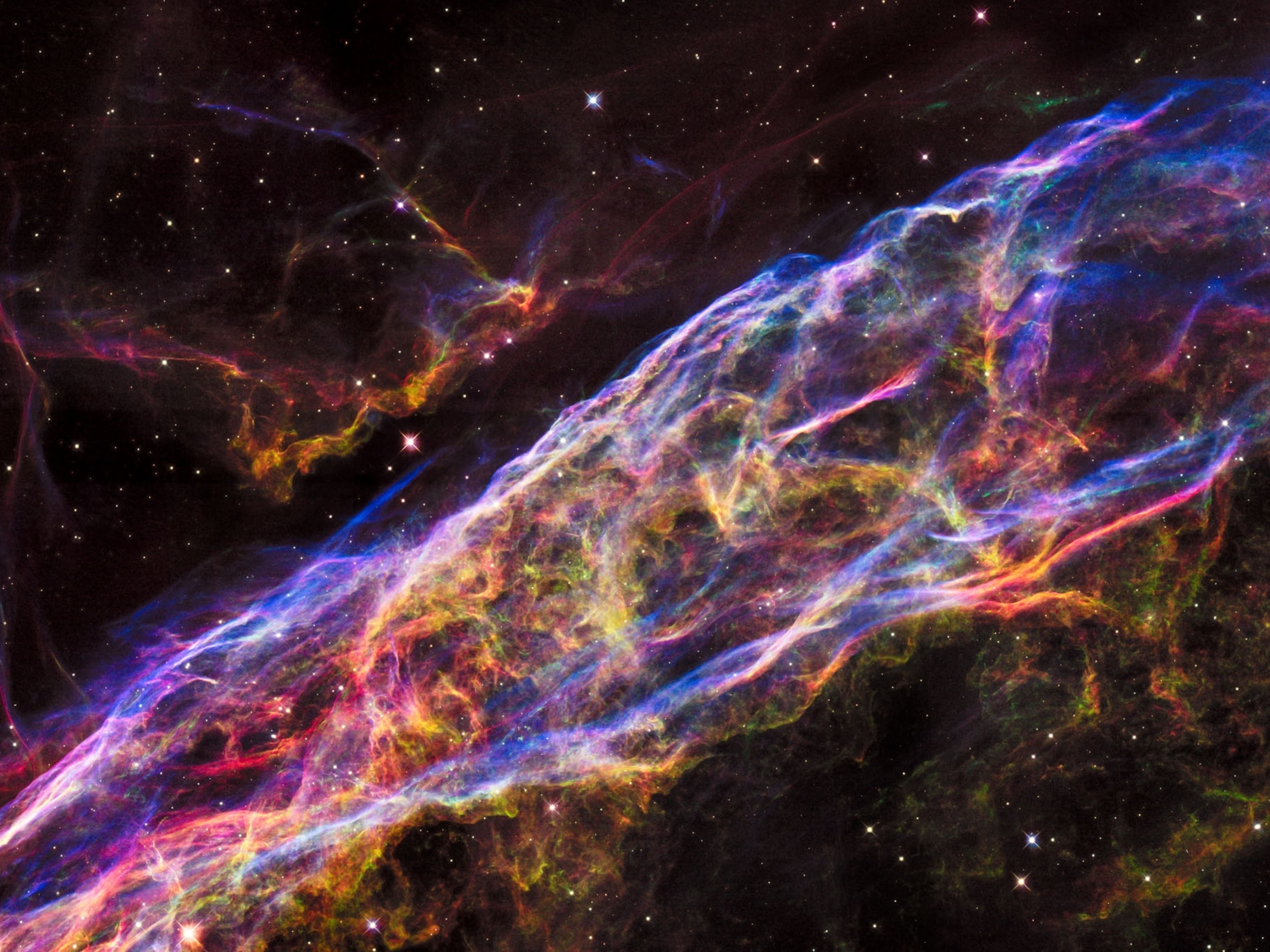
After 30 years, Hubble is still revealing new mysteries of the universe
- Environment
- Paid Content
History & Culture
- History & Culture
- History Magazine
- Mind, Body, Wonder
- Terms of Use
- Privacy Policy
- Your US State Privacy Rights
- Children's Online Privacy Policy
- Interest-Based Ads
- About Nielsen Measurement
- Do Not Sell or Share My Personal Information
- Nat Geo Home
- Attend a Live Event
- Book a Trip
- Inspire Your Kids
- Shop Nat Geo
- Visit the D.C. Museum
- Learn About Our Impact
- Support Our Mission
- Advertise With Us
- Customer Service
- Renew Subscription
- Manage Your Subscription
- Work at Nat Geo
- Sign Up for Our Newsletters
- Contribute to Protect the Planet
Copyright © 1996-2015 National Geographic Society Copyright © 2015-2024 National Geographic Partners, LLC. All rights reserved
Origins of the Universe 101
How old is the universe, and how did it begin? Throughout history, countless myths and scientific theories have tried to explain the universe's origins. The most widely accepted explanation is the big bang theory. Learn about the explosion that started it all and how the universe grew from the size of an atom to encompass everything in existence today.
Earth Science, Astronomy
Media Credits
The audio, illustrations, photos, and videos are credited beneath the media asset, except for promotional images, which generally link to another page that contains the media credit. The Rights Holder for media is the person or group credited.
Web Producer
Last updated.
October 19, 2023
User Permissions
For information on user permissions, please read our Terms of Service. If you have questions about how to cite anything on our website in your project or classroom presentation, please contact your teacher. They will best know the preferred format. When you reach out to them, you will need the page title, URL, and the date you accessed the resource.
If a media asset is downloadable, a download button appears in the corner of the media viewer. If no button appears, you cannot download or save the media.
Text on this page is printable and can be used according to our Terms of Service .
Interactives
Any interactives on this page can only be played while you are visiting our website. You cannot download interactives.
Related Resources

- school Campus Bookshelves
- menu_book Bookshelves
- perm_media Learning Objects
- login Login
- how_to_reg Request Instructor Account
- hub Instructor Commons
- Download Page (PDF)
- Download Full Book (PDF)
- Periodic Table
- Physics Constants
- Scientific Calculator
- Reference & Cite
- Tools expand_more
- Readability
selected template will load here
This action is not available.

8.1: Origin of the Universe
- Last updated
- Save as PDF
- Page ID 6888

- Chris Johnson, Matthew D. Affolter, Paul Inkenbrandt, & Cam Mosher
- Salt Lake Community College via OpenGeology
The universe appears to have an infinite number of galaxies and solar systems and our solar system occupies a small section of this vast entirety. The origins of the universe and solar system set the context for conceptualizing the Earth’s origin and early history.
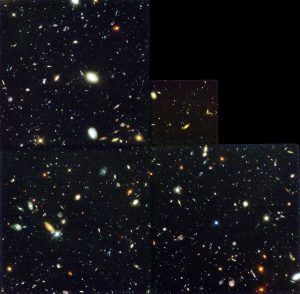
Big-Bang Theory

The mysterious details of events prior to and during the origin of the universe are subject to great scientific debate. The prevailing idea about how the universe was created is called the big-bang theory . Although the ideas behind the big-bang theory feel almost mystical, they are supported by Einstein’s theory of general relativity [ 1 ]. Other scientific evidence, grounded in empirical observations, supports the big-bang theory.
The big-bang theory proposes the universe was formed from an infinitely dense and hot core of the material. The bang in the title suggests there was an explosive, outward expansion of all matter and space that created atoms. Spectroscopy confirms that hydrogen makes up about 74% of all matter in the universe. Since its creation, the universe has been expanding for 13.8 billion years and recent observations suggest the rate of this expansion is increasing [ 2 ].
Spectroscopy
Spectroscopy is the investigation and measurement of spectra produced when materials interact with or emit electromagnetic radiation. Spectra is the plural for spectrum which is a particular wavelength from the electromagnetic spectrum . Common spectra include the different colors of visible light, X-rays, ultraviolet waves, microwaves, and radio waves. Each beam of light is a unique mixture of wavelengths that combine across the spectrum to make the color we see. The light wavelengths are created or absorbed inside atoms, and each wavelength signature matches a specific element. Even white light from the Sun, which seems like an uninterrupted continuum of wavelengths, has gaps in some wavelengths. The gaps correspond to elements present in the Earth’s atmosphere that act as filters for specific wavelengths. These missing wavelengths were famously observed by Joseph von Fraunhofer (1787–1826) in the early 1800s [ 3 ], but it took decades before scientists were able to relate the missing wavelengths to atmospheric filtering. Spectroscopy shows that the Sun is mostly made of hydrogen and helium. Applying this process to light from distant stars, scientists can calculate the abundance of elements in a specific star and visible universe as a whole. Also, this spectroscopic information can be used as an interstellar speedometer.
The Doppler effect is the same process that changes the pitch of the sound of an approaching car or ambulance from high to low as it passes. When an object emits waves, such as light or sound, while moving toward an observer, the wavelengths get compressed. In sound, this results in a shift to a higher pitch. When an object moves away from an observer, the wavelengths are extended, producing a lower-pitched sound. The Doppler effect is used on light emitted from stars and galaxies to determine their speed and direction of travel. Scientists, including Vesto Slipher (1875–1696) [ 6 ] and Edwin Hubble (1889–1953) [ 7 ], examined galaxies both near and far and found that almost all galaxies outside of our galaxy are moving away from each other, and us. Because the light wavelengths of receding objects are extended, visible light is shifted toward the red end of the spectrum, called a redshift . In addition, Hubble noticed that galaxies that were farther away from Earth also had a greater amount of redshift, and thus, the faster they are traveling away from us. The only way to reconcile this information is to deduce the universe is still expanding. Hubble’s observation forms the basis of the big-bang theory.
Cosmic Microwave Background Radiation
Another strong indication of the big-bang is cosmic microwave background radiation . Cosmic radiation was accidentally discovered by Arno Penzias (1933–) and Robert Woodrow Wilson (1936–) [ 8 ] when they were trying to eliminate background noise from a communication satellite. They discovered very faint traces of energy or heat that are omnipresent across the universe. This energy was left behind from the big bang, like an echo.
Stellar Evolution
Astronomers think the big bang created lighter elements, mostly hydrogen and smaller amounts of elements helium, lithium, and beryllium. Another process must be responsible for creating the other 90 heavier elements. The current model of stellar evolution explains the origins of these heavier elements.
Birth of a Star
Stars start their lives as elements floating in cold, spinning clouds of gas and dust known as nebulas . Gravitational attraction or perhaps a nearby stellar explosion causes the elements to condense and spin into a disk shape. In the center of this disk shape, a new star is born under the force of gravity. The spinning whirlpool concentrates material in the center, and the increasing gravitational forces collect even more mass. Eventually, the immensely concentrated mass of material reaches a critical point of such intense heat and pressure it initiates fusion.
Fusion is not a chemical reaction. Fusion is a nuclear reaction in which two or more nuclei, the centers of atoms, are forced together and combine creating a new larger atom. This reaction gives off a tremendous amount of energy, usually as light and solar radiation. An element such as hydrogen combines or fuses with other hydrogen atoms in the core of a star to become a new element, in this case, helium. Another product of this process is energy, such as solar radiation that leaves the Sun and comes to the Earth as light and heat. Fusion is a steady and predictable process, which is why we call this the main phase of a star’s life. During its main phase, a star turns hydrogen into helium. Since most stars contain plentiful amounts of hydrogen, the main phase may last billions of years, during which their size and energy output remains relatively steady.
The giant phase in a star’s life occurs when the star runs out of hydrogen for fusion. If a star is large enough, it has sufficient heat and pressure to start fusing helium into heavier elements. This style of fusion is more energetic and the higher energy and temperature expand the star to a larger size and brightness. This giant phase is predicted to happen to our Sun in another few billion years, growing the radius of the Sun to Earth’s orbit, which will render life impossible. The mass of a star during its main phase is the primary factor in determining how it will evolve. If the star has enough mass and reaches a point at which the primary fusion element, such as helium, is exhausted, fusion continues using new, heavier elements. This occurs over and over in very large stars, forming progressively heavier elements like carbon and oxygen. Eventually, fusion reaches its limit as it forms iron and nickel. This progression explains the abundance of iron and nickel in rocky objects, like Earth, within the solar system. At this point, any further fusion absorbs energy instead of giving it off, which is the beginning of the end of the star’s life [ 9 ].
Death of a Star
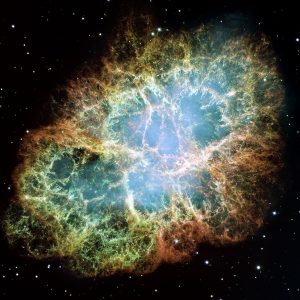
The death of a star can range from spectacular to other-worldly (see figure). Stars like the Sun form a planetary nebula, which comes from the collapse of the star’s outer layers in an event like the implosion of a building. In the tug-of-war between gravity’s inward pull and fusion’s outward push, gravity instantly takes over when fusion ends, with the outer gasses puffing away to form a nebula. More massive stars do this as well but with a more energetic collapse, which starts another type of energy release mixed with element creation known as a supernova. In a supernova , the collapse of the core suddenly halts, creating a massive outward-propagating shock wave. A supernova is the most energetic explosion in the universe short of the big bang. The energy release is so significant the ensuing fusion can make every element up through uranium [ 10 ].
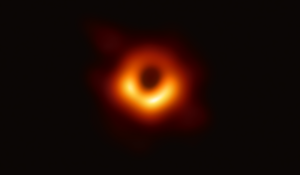
The death of the star can result in the creation of white dwarfs, neutron stars, or black holes. Following their deaths, stars like the Sun turn into white dwarfs.
White dwarfs are hot star embers, formed by packing most of a dying star’s mass into a small and dense object about the size of Earth. Larger stars may explode in a supernova that packs their mass even tighter to become neutron stars. Neutron stars are so dense that protons combine with electrons to form neutrons. The largest stars collapse their mass even further, becoming objects so dense that light cannot escape their gravitational grasp. These are the infamous black holes and the details of the physics of what occurs in them are still up for debate.
1. Einstein A (1917) Cosmological Reflections on the General Relativity Theory. Sitzungsberichte der Königlich Preußischen Akademie der Wissenschaften (Berlin), Seite 142-152 142–152
2. Perlmutter S, Aldering G, Goldhaber G (1999) Measurements of Omega and Lambda from 42 high-redshift supernovae. Astrophys J 517:565–586
3. Fraunhofer J (1817) Bestimmung des Brechungs-und des Farbenzerstreungs-Vermögens verschiedener Glasarten, in Bezug auf die Vervollkommnung achromatischer Fernröhre. Ann Phys 56:264–313. https://doi.org/10.1002/andp.18170560706
6. Slipher VM (1913) The radial velocity of the Andromeda Nebula. Lowell Observatory Bulletin 2:56–57
7. Hubble E (1929) A relation between distance and radial velocity among extra-galactic nebulae. Proc Natl Acad Sci U S A 15:168–173
8. Penzias AA, Wilson RW (1965) A Measurement of Excess Antenna Temperature at 4080 Mc/s. Astrophys J 142:419–421
9. Salaris M, Cassisi S (2005) Evolution of stars and stellar populations. John Wiley & Sons
10. Timmes FX, Woosley SE, Weaver TA (1995) Galactic chemical evolution: Hydrogen through zinc. The Astrophysical journal Supplement series 98:617–658
CERN Accelerating science

The early universe
All matter in the universe was formed in one explosive event 13.7 billion years ago – the Big Bang
The Big Bang
In 1929 the American astronomer Edwin Hubble discovered that the distances to far-away galaxies were proportional to their redshifts. Redshift occurs when a light source moves away from its observer: the light's apparent wavelength is stretched via the Doppler effect towards the red part of the spectrum. Hubble’s observation implied that distant galaxies were moving away from us, as the furthest galaxies had the fastest apparent velocities. If galaxies are moving away from us, reasoned Hubble, then at some time in the past, they must have been clustered close together.
Hubble’s discovery was the first observational support for Georges Lemaître’s Big Bang theory of the universe, proposed in 1927. Lemaître proposed that the universe expanded explosively from an extremely dense and hot state, and continues to expand today. Subsequent calculations have dated this Big Bang to approximately 13.7 billion years ago. In 1998 two teams of astronomers working independently at Berkeley, California observed that supernovae – exploding stars – were moving away from Earth at an accelerating rate. This earned them the Nobel prize in physics in 2011 . Physicists had assumed that matter in the universe would slow its rate of expansion; gravity would eventually cause the universe to fall back on its centre. Though the Big Bang theory cannot describe what the conditions were at the very beginning of the universe, it can help physicists describe the earliest moments after the start of the expansion.
In the first moments after the Big Bang, the universe was extremely hot and dense. As the universe cooled, conditions became just right to give rise to the building blocks of matter – the quarks and electrons of which we are all made. A few millionths of a second later, quarks aggregated to produce protons and neutrons. Within minutes, these protons and neutrons combined into nuclei. As the universe continued to expand and cool, things began to happen more slowly. It took 380,000 years for electrons to be trapped in orbits around nuclei, forming the first atoms. These were mainly helium and hydrogen, which are still by far the most abundant elements in the universe. Present observations suggest that the first stars formed from clouds of gas around 150–200 million years after the Big Bang. Heavier atoms such as carbon, oxygen and iron, have since been continuously produced in the hearts of stars and catapulted throughout the universe in spectacular stellar explosions called supernovae.
But stars and galaxies do not tell the whole story. Astronomical and physical calculations suggest that the visible universe is only a tiny amount (4%) of what the universe is actually made of. A very large fraction of the universe, in fact 26%, is made of an unknown type of matter called " dark matter ". Unlike stars and galaxies, dark matter does not emit any light or electromagnetic radiation of any kind, so that we can detect it only through its gravitational effects.
An even more mysterious form of energy called “dark energy” accounts for about 70% of the mass-energy content of the universe. Even less is known about it than dark matter. This idea stems from the observation that all galaxies seems to be receding from each other at an accelerating pace, implying that some invisible extra energy is at work.

Want to create or adapt books like this? Learn more about how Pressbooks supports open publishing practices.
13 Origins and the Universe
Formative Assessment: Timeline of the Universe

The Big Bang: Origins of our Universe
The Big Bang is the best-supported scientific theory for how the universe was created. 13.7 billion years ago there was nothing and nowhere. Everything that ever existed was contained in a subatomic particle that was billions of times smaller than an atom. Within a fraction of a second, this amazingly tiny particle stretched and inflated to an unimaginably huge size. Space, time, and the fundamental particles of the universe were created in this instant.
Key Takeaway
Although the word “bang” is part of the name, the Big Bang was an expansion or an inflation rather than an explosion.
Although there are alternate theories, the Big Bang theory is supported by multiple sources of scientific evidence.
- Edwin Hubble discovered that the universe is still expanding today. If it is constantly expanding and growing now, that means it was smaller before–and likely the size of an unimaginably small particle at the beginning.
- Scientists detected Cosmic Microwave Background, a type of radiation that is present everywhere in the universe. Evidence suggests that this is leftover radiation from the energy of the Big Bang.
For more explanation of the Big Bang theory, watch the following video.
Video credit: “ Big Bang Introduction ” by Khan Academy is licensed under CC BY-NC-SA 3.0 . Note: All Khan Academy content is available for free at khanacademy.org .
The Life Cycle of Stars
All stars begin their lives as clouds of gas and dust which are called nebulae . The particles in a nebula start to attract, so their combined mass increases. Therefore, they have more gravity which pulls in even more particles. Eventually, there will be enough particles under intense heat and pressure in the center core and nuclear fusion can occur. The star ignites and becomes a fully functioning star.
The image, below, shows the life cycles of different types of stars.
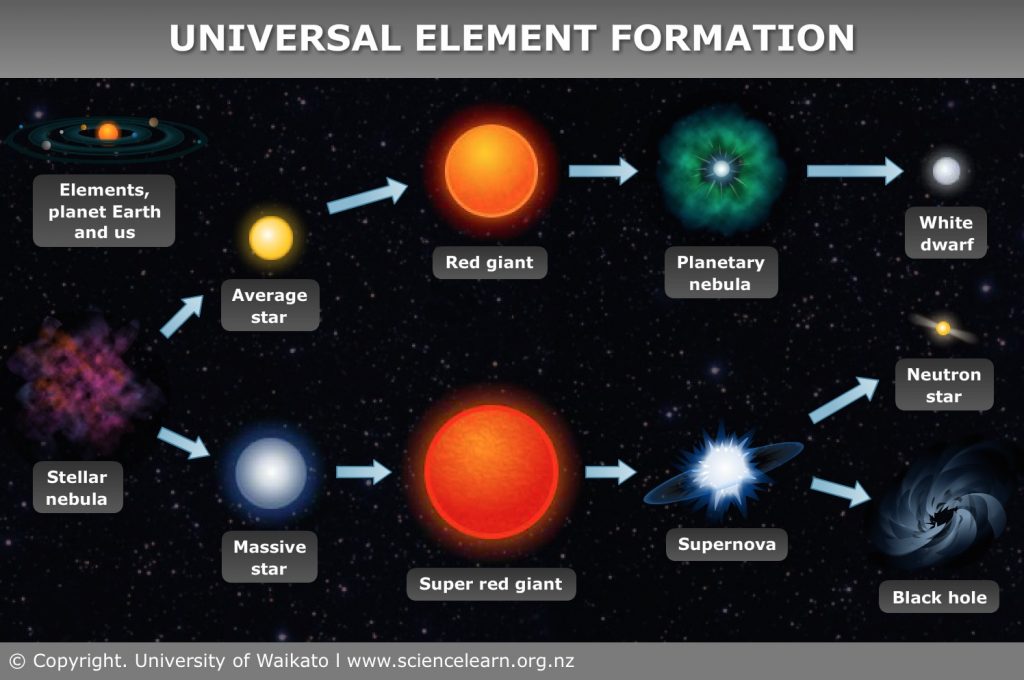
Depending on the amount of material in the nebula, an average star (like the Sun) or a supermassive star is formed. As the star burns through its fuel, it loses mass; therefore, it has less gravity and its size increases. An average star turns into a red giant . As it continues burning fuel, the red giant becomes very large. Then, the outer layers are blown off creating a planetary nebula and the inner core of the star remains, called a white dwarf star.
A supermassive star turns into a super red giant. These stars have more mass so they burn through their fuel more quickly, therefore losing gravity and becoming extremely large. Eventually, the super red giant will run out of fuel, collapse in on itself, and create a giant explosion called a supernova . From there, the star can either form a black hole or an extremely compact neutron star.
Interesting Fact: We Are Made of Stardust
- Nuclear fusion in stars begins with hydrogen atoms which fuse together to make helium. Eventually, the reactions increase and atoms continue fusing into different elements; stars can fuse all of the elements up to iron on the periodic table.
- When the dust and debris from a star is blown away in a planetary nebula or supernova, all of these elements scatter into space where they will become the basis for all new stars and matter in the universe. Therefore, we are made of stardust.
Origins of the Sun, Earth, and Moon
Our solar system was most likely formed from a giant rotating nebula after a former star underwent a supernova . 4.65 billion years ago, this rotation and intense gravity caused the nebula to collapse on itself. This caused it to spin faster and flatten into a disk shape, the Plane of the Ecliptic . Much of this material was pulled toward the center of the disk and a star was formed: the Sun. The Sun contains 99.8% of the mass in our solar system.
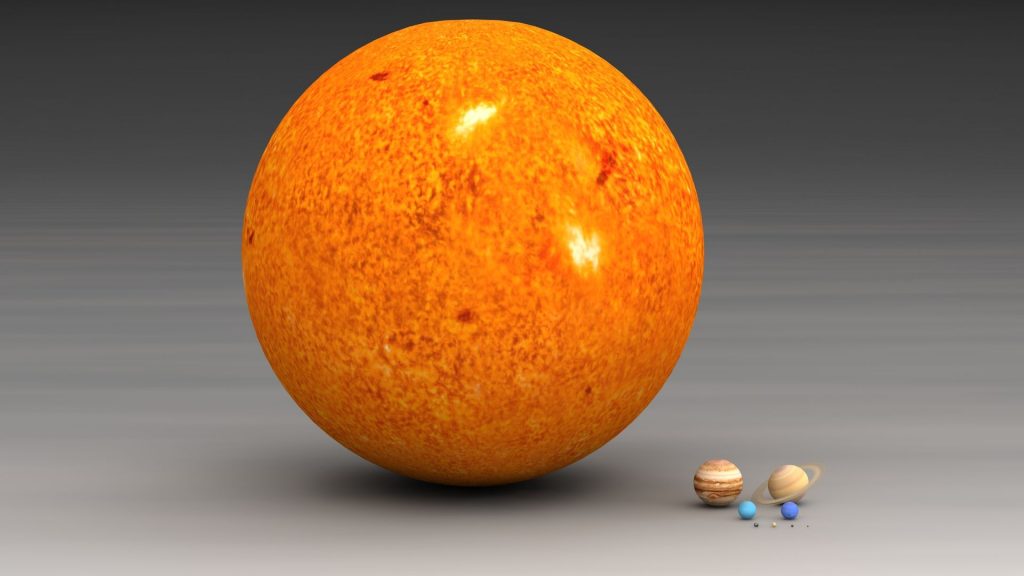
Although it is enormous compared to the size of Earth, the Sun is an average-sized star. It is mostly made of hydrogen and helium. Currently, it is halfway through its fuel supply. In around 5-6 billion years, the Sun will burn all of its fuel and become a white dwarf star.
After the Plane of the Ecliptic was formed, the planets formed from the leftover gas and dust orbiting around the Sun. One theory says that when the Sun turned on and became a star, the force of its energy blew off the gas clouds around the four inner planets which is why they are rocky and the outer planets are gaseous. Earth, a rocky planet, is about 4.65 billion years old. Scientists believe that life on Earth appeared approximately 3.5 billion years ago, based on evidence found in fossils.
For more detail of how space dust turns into planets, watch the video below:
Video credit: “ The Dust Bunnies That Build Our Planet ” by Lorin Swint Matthews/ TED-Ed is licensed under CC BY-NC-ND 4.0
Earth was NOT formed during the Big Bang.
- The Big Bang occurred 13.7 billion years ago.
- Earth was formed 4.65 billion years ago.
- This means there is a lapse of 9 billion years between the Big Bang and the formation of Earth.
The Moon was formed when a Mars-sized object named Theia collided with the Earth. Early in its creation, Earth was molten. When it collided with Theia, chunks of Earth’s crust were ejected into space. Gravity bounded these pieces together and the Moon was formed, eventually cooling and hardening into its current rocky state. Evidence which supports this theory include that the Moon and Earth have very similar composition including an iron core, mantle, and crust, although the Moon is less dense since it was formed from lighter elements in Earth’s crust. The Moon is held to Earth by gravity and it is Earth’s only natural satellite object, although the distance between them is increasing by about 1.6 inches per year.
Characteristics of the Moon
- Distance from Earth : 239,000 miles
- Size : As seen in the image, below, the Moon is about 1/4 the size of Earth.
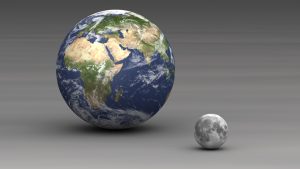
- Very similar to Earth
- Has an iron core , mantle , and crust
- It does not have an atmosphere to protect it from the impact of objects such as asteroids in space.
- There is no wind on the Moon to erode existing craters.
- Climate : The Moon has no atmosphere, wind, or weather. Thus, the temperature can range from extremely hot to extremely cold since there is no atmosphere to protect it from the Sun’s heat or insulate the surface.
- The Moon’s gravity, although weaker than Earth’s gravity, has enough pull to move water. This is what causes tides on Earth. As Earth rotates on its axis, the area on the near side of the Moon feels its gravity. As seen in the image below, this causes the water on that side–as well as the opposite side of Earth–to bulge out and create a high tide. As Earth continues to rotate, the gravitational pull weakens and the water recedes, creating a low tide. Since Earth completes one full rotation on its axis each day, most areas have two high tides and two low tides per day.
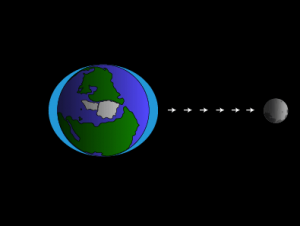
Sides of the Moon
There are two sides of the moon: the near side (the side we can see from Earth) and the far side (also known as the dark side). The Moon does not create its own light; it gets light from the Sun. As such, the dark side is not actually dark–it is just called the dark side because we cannot see it from Earth.
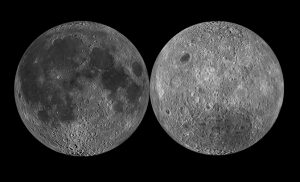
Since Earth has a larger mass, it exerts a stronger gravitational pull on the Moon. Earth’s pull controls the Moon’s orbit so that the Moon rotates once on its axis in the same amount of time it takes to orbit Earth. Therefore, the same side of the Moon is always facing Earth and we have a near side and a dark side. This effect is called tidal locking.
Click this link to see an animation of how tidal locking works as the Moon orbits Earth.
A galaxy is a collection of billions of stars, gas, and dust held together by gravity in space. Using the Hubble Space Telescope, scientists can take images of space. In one small area, called the eXtreme Deep Field or XDF (image below) each of the bright spots is an entire galaxy–there are 5,550 galaxies within the image. There are probably 100 hundred billion galaxies in the entire universe.
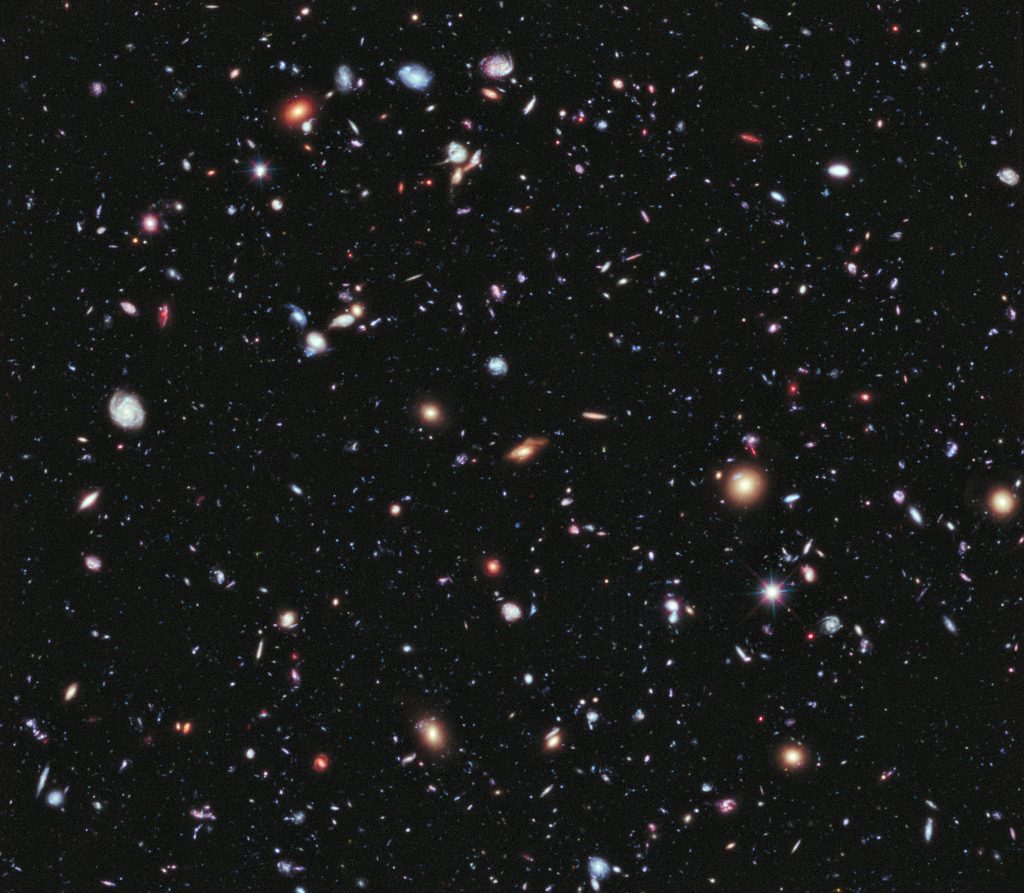
The Milky Way
A galaxy is a collection of billions of stars, gas, and dust held together by gravity in space. Our solar system is located in the Milky Way Galaxy. As seen in the image, below, it got its name because it appears as a milky band of light in the sky.
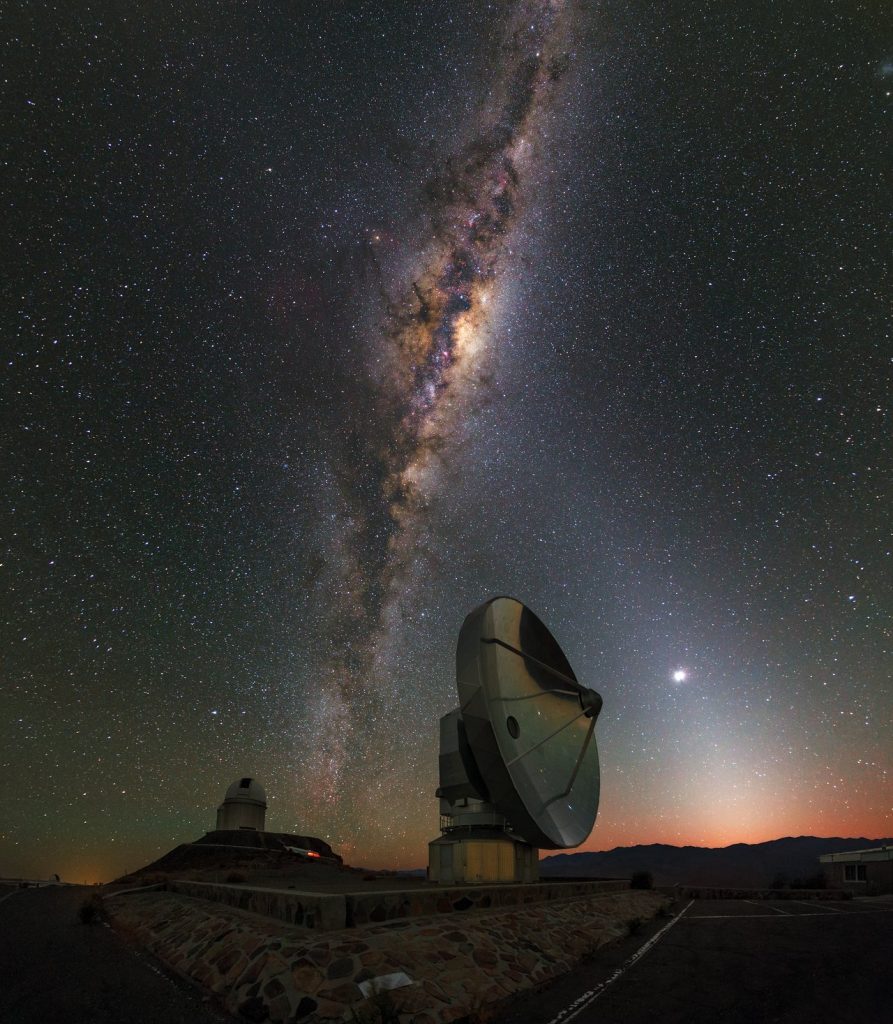
As seen in the image, below, the Milky Way is a large spiral-shaped galaxy which contains hundreds of billions of stars. At the center of the Milky Way is a supermassive black hole named Sagittarius A which has a mass of 4 million suns. Our Sun, Earth, and all the planets are located halfway between the center and the outer edge on a small partial arm called the Orion Spur.
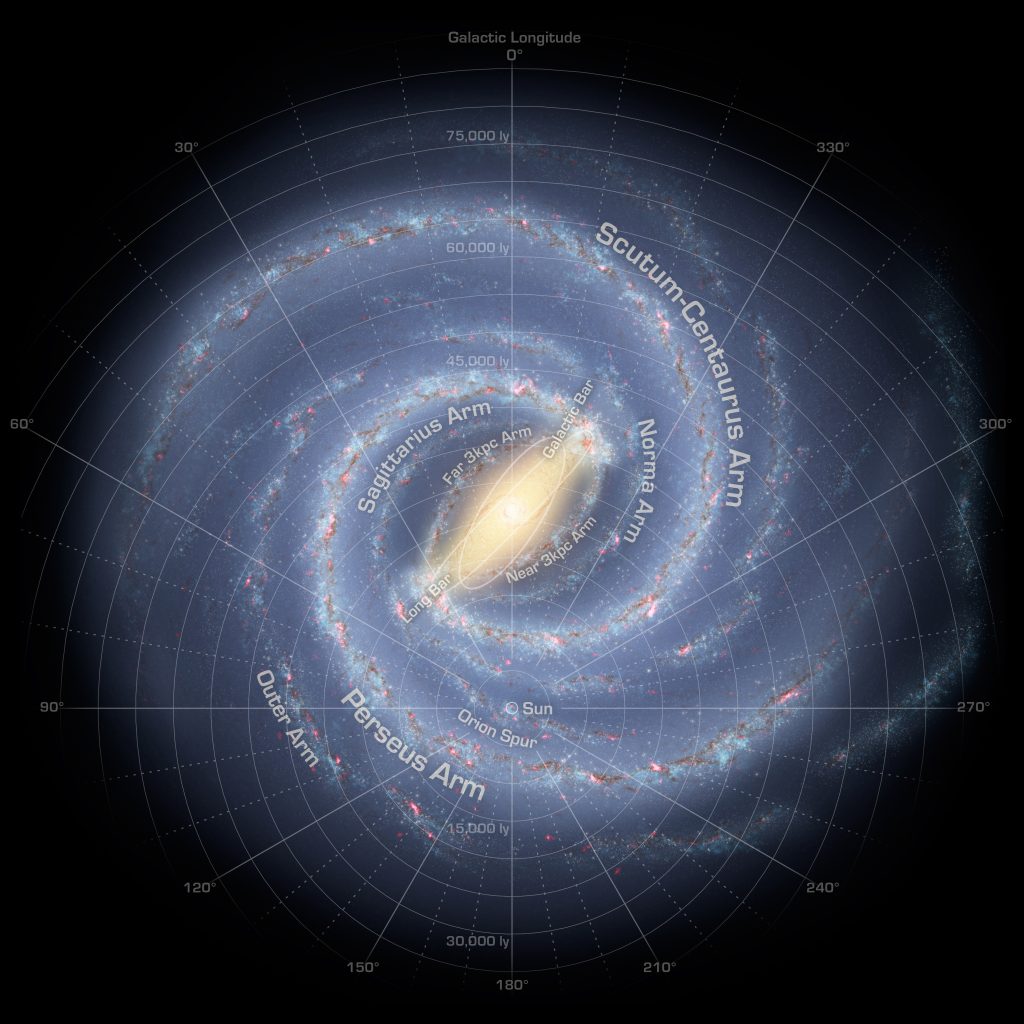
As seen in the image, below, there are 3 shapes of galaxies: spiral, elliptical, and irregular. Our galaxy, the Milky Way, is a spiral galaxy. Most galaxies have a supermassive black hole at the center which has an extremely strong gravitational pull that holds the entire galaxy together.
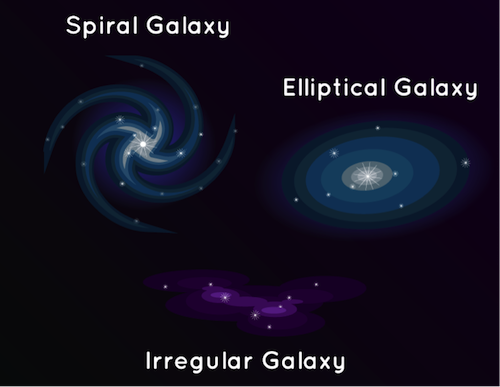
Past, Present, and Future of Space Travel: Sputnik and the Space Race
On October 4th, 1957 the Soviet Union successfully launched Sputnik, the world’s first artificial satellite, into Earth’s orbit. This successful launch of Sputnik sparked the Space Race between the Soviet Union and the United States. These two countries competed to get the first human to land on the Moon.
On January 31, 1958, the United States launched Explorer 1, a satellite that discovered the magnetic radiation belts around Earth. That same year, the United States created the National Aeronautics and Space Administration (NASA). In 1959, the Soviet Union launched Luna 2, the first spacecraft to land on the Moon. In April 1961, the Soviet astronaut Yuri Gagarin became the first person in space when he orbited Earth. Shortly after, astronaut Alan Shepard became the first American in space in May 1961.
The Space Race heated up and President John F. Kennedy claimed that the United States would put a man on the Moon before the end of the decade. In 1962, American astronaut John Glenn successfully orbited the Earth. In 1968, American mission Apollo 8 orbited the Moon. Finally, in 1969, the American mission Apollo 11 successfully landed the first two people on the Moon: astronauts Neil Armstrong and Buzz Aldrin.

Interesting Fact
Dr. James Van Allen from the University of Iowa created the radiation detector that launched on the Explorer 1 satellite. This led to the discovery of magnetic radiation belts around Earth which are known as Van Allen radiation belts in his honor. Van Allen Hall on Iowa’s campus is also named after him.
Women and Space
Traditionally, the story of the Space Race features male scientists and astronauts. However, women have played a key role in the history of American space exploration. NASA mathematicians Katherine Johnson and Dorothy Vaughan along with engineer Mary Jackson were key members of the team that launched John Glenn into space in 1962. In addition to this mission, these women had long careers at NASA. Their stories have recently been popularized in the movie Hidden Figures .

Initially, women were seen to have a physical advantage as astronauts; they tend to be lighter, shorter, and consume less food. In 1960, astronaut Jerrie Cobb had logged twice as many flying hours as John Glenn. But NASA made a requirement that astronauts had to be military pilots, a job only men could have. A group of 13 female astronauts, including Cobb, was gathered and subjected to the same tests as the male astronauts. The women passed all of the tests, and in many cases, performed better than the men. Still, NASA refused to support the female astronauts. In 1983, Sally Ride became the first female astronaut in space.
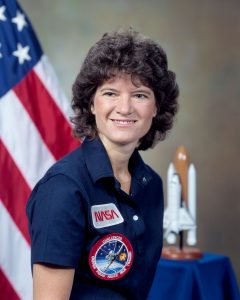
Black Holes
A black hole is an area in space with extremely strong gravity from which no light can escape. Thus, the area appears black. At the end of its lifecycle, a supermassive star collapses in on itself which causes a huge explosion called a supernova ; this results in the formation of a black hole.
Seen below, scientists captured the first image of a black hole in 2019 using powerful telescopes.
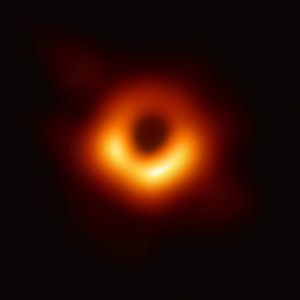
Since black holes trap all light inside, the dark spot in the center of the image is the black hole’s shadow surrounded by a ring of glowing gas in space. Based on this image, scientists were able to determine that the this black hole’s mass is 6.5 billion times larger than the mass of our Sun.
Katie Bouman, a female graduate student at MIT, led the creation of the computer algorithm that made it possible to get this first image of a black hole.
For more explanation of black holes, watch the following video.
Video credit: “ What is a Black Hole? ” by NASA Space Place is public domain
Performance Expectations
fifth grade
ESS1.A: The Universe and its Stars
- The sun is a star that appears larger and brighter than other stars because it is closer. Stars range greatly in their distance from Earth. (5-ESS1-1)
middle school
ESS1.A: The Universe and Its Stars
- Patterns of the apparent motion of the sun, the moon, and stars in the sky can be observed, described, predicted, and explained with models. (MS-ESS1-1)
- Earth and its solar system are part of the Milky Way galaxy, which is one of many galaxies in the universe. (MS-ESS1-2)
ESS1.B: Earth and the Solar System
- The solar system consists of the sun and a collection of objects, including planets, their moons, and asteroids that are held in orbit around the sun by its gravitational pull on them. (MS-ESS1-2),(MS-ESS1-3)
- The solar system appears to have formed from a disk of dust and gas, drawn together by gravity. (MS-ESS1-2)
Crosscutting Concepts
Scale, Proportion, and Quantity
- Natural objects exist from the very small to the immensely large. (5-ESS1-1)
- Patterns can be used to identify cause-and-effect relationships. (MS-ESS1-1)
- Time, space, and energy phenomena can be observed at various scales using models to study systems that are too large or too small. (MS-ESS1-3)
Systems and System Models
- Models can be used to represent systems and their interactions. (MS-ESS1-2)
– – – – – – – – – – – – – – – – – – – – – – – – – – –
Scientific theory for how the universe was created.
A cloud of gas and dust in space.
The process by which stars get their energy. Atoms fuse together creating a nuclear reaction which releases energy in the form of heat and light in the star.
Phase in a star's life cycle where it greatly increases in size as it burns fuel through nuclear fusion.
The giant explosion of a supermassive star at the end of its life cycle.
An area in space with extremely strong gravity from which no light can escape.
The disk-shaped plane in which everything in our solar system orbits around the Sun.
The innermost layers of Earth; made of a liquid outer core and a solid inner core.
The middle layer of Earth between the crust and the core.
The outermost layer of Earth.
Depression formed by an impact.
A meteoroid that survives its trip through the atmosphere and lands somewhere on Earth. The impact of a meteorite can cause a crater on the surface of a planet.
Rocky celestial bodies left over from the formation of the solar system that are smaller than planets and orbit the Sun.
Process by which broken down rocks are carried to a new location.
A collection of billions of stars, gas, and dust held together by gravity in space.
Our Sun and all of the planets and other bodies in space (comets, asteroids, meteoroids) that orbit around the Sun in the plane of the ecliptic.
Science for Developing Scientifically Literate Citizens Copyright © 2019 by Dr. Ted Neal is licensed under a Creative Commons Attribution-NonCommercial-ShareAlike 4.0 International License , except where otherwise noted.
Share This Book
The history of the universe: Big Bang to now in 10 easy steps
Take a trip through time to discover the history of the universe.
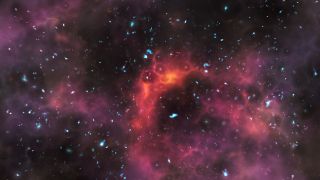
Step 1: How it all started
Step 2: the universe's first growth spurt, step 3: too hot to shine, step 4: let there be light, step 5: emerging from the cosmic dark ages, step 6: more stars and more galaxies, step 7: birth of our solar system, step 8: the invisible stuff in the universe, step 9: the expanding and accelerating universe, step 10: we still need to know more, additional resources, bibliography.
The history of the universe and how it evolved is broadly accepted as the Big Bang model, which states that the universe began as an incredibly hot, dense point roughly 13.7 billion years ago. So, how did the universe go from being fractions of an inch (a few millimeters) across to what it is today? Here is a breakdown of the Big Bang to now in 10 easy-to-understand steps.

The Big Bang was not an explosion in space, as the theory's name might suggest. Instead, it was the appearance of space everywhere in the universe, researchers have said. According to the Big Bang theory, the universe was born as a very hot, very dense, single point in space. Cosmologists are unsure what happened before this moment, but with sophisticated space missions, ground-based telescopes and complicated calculations, scientists have been working to paint a clearer picture of the early universe and its formation. A key part of this comes from observations of the cosmic microwave background , which contains the afterglow of light and radiation left over from the Big Bang. This relic of the Big Bang pervades the universe and is visible to microwave detectors, which allows scientists to piece together clues of the early universe. In 2001, NASA launched the Wilkinson Microwave Anisotropy Probe (WMAP) mission to study the conditions as they existed in the early universe by measuring radiation from the cosmic microwave background. Among other discoveries, WMAP was able to determine the age of the universe — about 13.7 billion years old.
When the universe was very young — something like a hundredth of a billionth of a trillionth of a trillionth of a second (whew!) — it underwent an incredible growth spurt. During this burst of expansion, which is known as inflation, the universe grew exponentially and doubled in size at least 90 times.
"The universe was expanding, and as it expanded, it got cooler and less dense," David Spergel, a theoretical astrophysicist at Princeton University in Princeton, N.J., told SPACE.com. After inflation, the universe continued to grow, but at a slower rate.
As space expanded, the universe cooled and matter formed.
Light chemical elements were created within the first three minutes of the universe's formation. As the universe expanded, temperatures cooled and protons and neutrons collided to make deuterium, which is an isotope of hydrogen. Much of this deuterium combined to make helium.

For the first 380,000 years after the Big Bang, however, the intense heat from the universe's creation made it essentially too hot for light to shine. Atoms crashed together with enough force to break up into a dense, opaque plasma of protons, neutrons and electrons that scattered light like fog.
About 380,000 years after the Big Bang, matter cooled enough for electrons to combine with nuclei to form neutral atoms. This phase is known as "recombination," and the absorption of free electrons caused the universe to become transparent. The light that was unleashed at this time is detectable today in the form of radiation from the cosmic microwave background. Yet, the era of recombination was followed by a period of darkness before stars and other bright objects were formed.
Roughly 400 million years after the Big Bang, the universe began to come out of its dark ages. This period in the universe's evolution is called the age of re-ionization. This dynamic phase was thought to have lasted more than a half-billion years, but based on new observations, scientists think re-ionization may have occurred more rapidly than previously thought. During this time, clumps of gas collapsed enough to form the very first stars and galaxies. The emitted ultraviolet light from these energetic events cleared out and destroyed most of the surrounding neutral hydrogen gas. The process of re-ionization, plus the clearing of foggy hydrogen gas, caused the universe to become transparent to ultraviolet light for the first time.
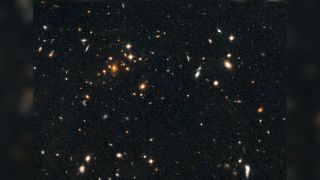
Astronomers comb the universe looking for the most far-flung and oldest galaxies to help them understand the properties of the early universe. Similarly, by studying the cosmic microwave background, astronomers can work backwards to piece together the events that came before. Data from older missions like WMAP and the Cosmic Background Explorer (COBE), which launched in 1989, and missions still in operation, like the Hubble Space Telescope, which launched in 1990, all help scientists try to solve the most enduring mysteries and answer the most debated questions in cosmology.
Our solar system is estimated to have been born a little after 9 billion years after the Big Bang, making it about 4.6 billion years old. According to current estimates, the sun is one of more than 100 billion stars in our Milky Way galaxy alone, and orbits roughly 25,000 light-years from the galactic core.
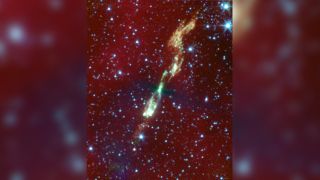
Many scientists think the sun and the rest of our solar system was formed from a giant, rotating cloud of gas and dust known as the solar nebula. As gravity caused the nebula to collapse, it spun faster and flattened into a disk. During this phase, most of the material was pulled toward the center to form the sun.
In the 1960s and 1970s, astronomers began thinking that there might be more mass in the universe than what is visible. Vera Rubin , an astronomer at the Carnegie Institution of Washington, observed the speeds of stars at various locations in galaxies. Basic Newtonian physics implies that stars on the outskirts of a galaxy would orbit more slowly than stars at the center, but Rubin found no difference in the velocities of stars farther out. In fact, she found that all stars in a galaxy seem to circle the center at more or less the same speed. This mysterious and invisible mass became known as dark matter . Dark matter is inferred because of the gravitational pull it exerts on regular matter. One hypothesis states the mysterious stuff could be formed by exotic particles that don't interact with light or regular matter, which is why it has been so difficult to detect.

In the 1920s, astronomer Edwin Hubble made a revolutionary discovery about the universe. Using a newly constructed telescope at the Mount Wilson Observatory in Los Angeles, Hubble observed that the universe is not static, but rather is expanding. Decades later, in 1998, the prolific space telescope named after the famous astronomer, the Hubble Space Telescope , studied very distant supernovas and found that, a long time ago, the universe was expanding more slowly than it is today. This discovery was surprising because it was long thought that the gravity of matter in the universe would slow its expansion, or even cause it to contract.
– How big is the universe?
– What is the coldest place in the universe?
– How many black holes are there in the universe?
– What color is the universe?
Dark energy is thought to be the strange force that is pulling the cosmos apart at ever-increasing speeds, but it remains undetected and shrouded in mystery. The existence of this elusive energy, which is thought to make up 80% of the universe, is one of the most hotly debated topics in cosmology.
While much has been discovered about the creation and evolution of the universe, there are enduring questions that remain unanswered. Dark matter and dark energy remain two of the biggest mysteries, but cosmologists continue to probe the universe in hopes of better understanding how it all began.
The James Webb Space Telescope (JWST), launched in 2021, will continue the hunt for the elusive dark matter, as well as peering back to the beginning of time and the evolution of the universe using its infrared instruments.

For more information about the evolution of the universe check out, " The History of the Universe " by David H. Lyth or " A Brief History of Time " by Stephen Hawking. You can also keep up to date with the discoveries of JWST, visit NASA's dedicated webpage or the European Space Agency's dedicated webpage .
Scientific American, " The Evolution of the Universe ", October 1994.
Walter Perry, " Origin and Evolution of the Universe ", Journal of Modern Physics, Volume 12, November 2021.
Bharat Ratra and Michael S. Vogeley, " The Beginning and Evolution of the Universe ", Publications of the Astronomical Society of the Pacific, Volume 120, March 2008,
NASA, " Brief History of the Universe ", December 2006.
Join our Space Forums to keep talking space on the latest missions, night sky and more! And if you have a news tip, correction or comment, let us know at: [email protected].
Get the Space.com Newsletter
Breaking space news, the latest updates on rocket launches, skywatching events and more!

Scott is a staff writer for How It Works magazine and has previously written for other science and knowledge outlets, including BBC Wildlife magazine, World of Animals magazine, Space.com and All About History magazine . Scott has a masters in science and environmental journalism and a bachelor's degree in conservation biology degree from the University of Lincoln in the U.K. During his academic and professional career, Scott has participated in several animal conservation projects, including English bird surveys, wolf monitoring in Germany and leopard tracking in South Africa.
NASA gets $25.4 billion in White House's 2025 budget request
'Interstellar meteor' vibrations actually caused by a truck, study suggests
Total solar eclipse 2024: Live updates
Most Popular
By All About Space magazine May 28, 2023
By Fran Ruiz May 06, 2023
- 2 Total solar eclipse 2024 thrills millions across North America (video, photos)
- 3 Total solar eclipse 2024 has begun and here are the first views!
- 4 Total solar eclipse 2024: Pictures from around the web
- 5 In Indiana, the best spot to see the 2024 solar eclipse is wherever you are

Origin Of The Universe: 8 Different Theories
How did the Universe we know come into existence? And how do we explain its origin? These are some of the questions cosmologists and physicists have been trying to unravel for decades.
Undoubtedly, every piece of evidence and data collected over the years by cosmologists points toward the possibility that it all might have started with a ‘big bang.’ But what if there is more?
Table of Contents
What Is The Big Bang Theory? A Brief Introduction
In 1927, Belgian astronomer Georges Lemaitre proposed the theory of an expanding universe (later confirmed by Edwin Hubble). He theorized that an expanding universe could be traced back to a singular point, which he termed the “primeval atom,” back in time. It laid the foundation for the modern Big Bang theory.
The Big Bang Theory is an explanation, based mostly on mathematical models, of how and when the Universe came into existence.
The cosmological model of the Universe described in the Big Bang theory explains how it initially expanded from a state of infinite density and temperature, known as the primordial (or gravitational) singularity.
This expansion was followed by cosmic inflation and a massive temperature drop. During this phase, the Universe ballooned at a much faster rate than the speed of light (by a factor of 10 26 ).
Subsequently, the Universe was reheated to a point where elementary particles (quarks, leptons, and so on) before a gradual decrease in temperature (and density) led to the formation of the first protons and neutrons .
A few minutes into the expansion, protons and neutrons combine to form primordial hydrogen and helium-4 nuclei. The estimated radius of the observable Universe during this phase was 300 light-years. The earliest stars and galaxies appeared about 400 million years after the event.
A crucial piece of the Big Bang model is the cosmic microwave background (CMB), which is the electromagnetic radiation left from the time when the Universe was in its infancy. CMB remains the most definitive proof of the Big Bang.
While the theory remains widely accepted across the scientific spectrum, a few alternative explanations — such as steady-state Universe and eternal inflation, have gained attraction over the years.
Below, we have discussed seven of the most popular alternatives of the Big Bang, explaining the origin of the Universe.
8. Quantum Fluctuation Theory
According to quantum mechanics, particles and antiparticles can spontaneously appear and annihilate in empty space. While doing so, they create temporary fluctuations in energy called vacuum fluctuations.
The quantum fluctuation theory proposes that our universe might have formed from one of those vacuum fluctuations. Image a very small space where an energy fluctuation occurs. Instead of quickly annihilating, this fluctuation could potentially increase and develop something more substantial.
This theory suggests that the initial fluctuation expanded rapidly, which eventually led to the birth of our universe. This rapid expansion can be associated with comic inflation.
As our universe expanded and cooled, the energy from the initial fluctuation might have transformed into particles and antiparticles. These particles would ultimately become the building blocks of matter throughout the cosmos.
Although the concept seems intriguing, it is just a theoretical framework. The precise details of how our universe formed from a quantum fluctuation remain a subject of active research. Scientists continue to study and refine this theory to get deeper insights into the origin of the universe.
Reference Sources –
Spontaneous creation of the universe from nothing, arXiv :1404.1207
Massive galaxy clusters hint at primordial quantum diffusion, Physics Review Letters

7. Theory of Eternal Inflation
The concept of the inflationary universe was first introduced by cosmologist Alan Guth in 1979 to explain why the Universe is flat, something that was missing from the original Big Bang theory.
Though Guth’s idea of inflation explains the flat Universe, it creates a scenario that prevents the Universe from escaping that inflation . If this were the case, reheating of the Universe wouldn’t have taken place, and neither would the formation of stars and galaxies.
This particular problem was solved by Andreas Albrecht and Paul Steinhardt in their “new inflation” model. They argued that rapid inflation of the Universe happened just for a few seconds before ceasing. It demonstrated how the Universe can go through rapid inflation and still end up getting heated.
Based on the previous works of Steinhardt and Alexander Vilenkin, Andrei Linde, a professor at Stanford University, proposed an alternative to Guth’s inflation theory called chaotic inflation or ‘eternal inflation theory.
The theory argues that the inflationary phase of the Universe goes on forever; it didn’t end for the Universe as a whole. In other words, cosmic inflation continues in some parts of the Universe and ceases in others. This leads to a multiverse scenario, wherein space is broken into bubbles. It’s like a universe inside a universe.
In a multiverse, different universes may have different laws of nature and physics at work. So, instead of a single expanding cosmos, our Universe might be an inflationary multiverse with many small universes with varying properties.
However, Paul Steinhardt believes that his ‘new inflation’ theory doesn’t lead to or predict anything and argues that the multiverse notion is a “fatal flaw” and unnatural.
Eternal inflation and its implications, arXiv :hep-th/0702178
Inflationary paradigm in trouble after Planck2013, arXiv :1304.2785
6. Conformal Cyclic Model
The conformal cyclic cosmological (CCC) model speculates that the Universe goes through repeated cycles of the Big Bang and subsequent expansions. The general idea is that the ‘Big Bang’ was not the beginning of the Universe but rather a transition phase. It was developed by renowned theoretical physicist and mathematician Roger Penrose.
The theory suggests that the universe goes through a series of cycles, each involving a Big Bang followed by expansion, contraction, and another Big Bang. These cycles are infinite, which means the universe goes through this process repeatedly with no end.
This concept is often compared with a spring oscillation, where the universe expands and contracts periodically.
Unlike the standard Big Bang theory that postulates a singular beginning of the universe, the Cyclic Universe theory avoids the singularity problem by suggesting that our universe had no initial singularity but has always existed in this cyclical pattern.
As a basis for his model, Penrose used multiple FLRW (Friedmann–Lemaître–Robertson–Walker) metric sequences. He argued that the conformal boundary of one FLRW sequence could be attached to the boundary of another.
The FLRW metric is the closest approximation of the nature of the Universe and a part of the Lambda-CDM model . Each sequence begins with a big bang, followed by inflation and subsequent expansion.
The cyclic or oscillating model, wherein the Universe reiterates over and over in an indefinite cycle, first came into the spotlight in the 1930s, when Albert Einstein investigated the idea of an ‘everlasting’ universe. He considered that after reaching a certain point, the Universe starts collapsing and ends with a Big Crunch before going through the Big Bounce.
Right now, there are four different variations of the cyclic model of the Universe, one of which is the Conformal Cyclic Cosmology.
Read: Does Universe Iterate Through Infinite Numbers of Big Bangs?
This theory has been studied extensively, but it faces some serious challenges in terms of observational evidence. One of the major challenges has been detecting remnants of past cycles in our current universe.
5. Black Hole Mirage
A study conducted by a group of researchers in 2013 speculated that our Universe might have originated from the debris spewed out of a collapsed four-dimensional star or a black hole.
According to the cosmologists associated with the research, one of the limitations of the Big Bang theory is to explain the temperature equilibrium found in the Universe.
While most scientists concur that the inflationary theory gives an adequate explanation of how a small patch with uniform temperature would rapidly expand to become the Universe we observe today, the group found it implausible due to the chaotic nature of the Big Bang.
To solve this problem, the team proposed a model of the cosmos, in which our three-dimensional Universe is a membrane and is floating inside a four-dimensional ‘bulk universe.’
They argued that if the 4-D ‘bulk universe’ has 4-D stars, it’s likely they will collapse into 4-D black holes. These 4-D black would have a 3-D event horizon (just like the 3-D ones have a 2-D event horizon ), which they named ‘hypersphere.’
Read: 11 Biggest Unsolved Mysteries in Physics
When the team simulated the collapse of a 4-D star, they discovered that the ejected debris from the dying star was likely to cast a 3-D membrane around that 3-D event horizon. Our Universe might be one such membrane.
The ‘4-D black hole’ model of the cosmos does explain why the temperature is almost uniform throughout the Universe. It may also give valuable insights into exactly what triggered the cosmic inflation a few seconds after its genesis.
However, a recent observation by ESA’s Planck satellite has uncovered small variations in the cosmic microwave background (CMB) temperature. These satellite readings differ from the proposed model by about four percent.
4. Plasma Universe Theory
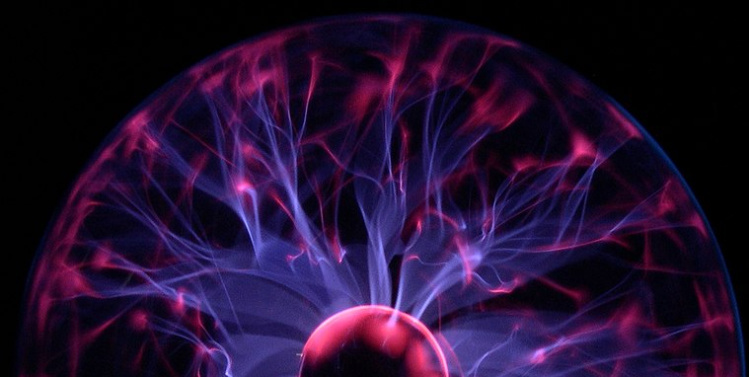
Our current understanding of the Universe is mostly influenced by gravity, specifically Einstein’s General Theory of Relativity, through which cosmologists explain the nature of the Universe. Coincidentally, just like most other things, an alternative to gravity has also been entertained by scientists over the years.
The plasma cosmology (or plasma universe theory) speculates that electromagnetic forces and plasma play a much more important role in the Universe than gravity.
Although the approach has many different flavors, the basic idea remains the same: every astronomical body, including the sun, stars, and galaxies, results from some electrical process.
The first prominent plasma universe theory was proposed by Nobel laureate Hannes Alfvén in the 1960s. He was later joined by Swedish theoretical physicist Oskar Klein to develop the Alfvén–Klein model .
The model is built around the assumption that the Universe sustains equal amounts of matter and antimatter (that’s not the case according to modern particle physics). The boundaries of these two regions are marked with cosmic electromagnetic fields. And thus, interactions between the two would produce plasma, which Alfvén named ‘ambiplasma.’
According to the theory, such plasma would form large sections of matter and antimatter throughout the Universe. Furthermore, it theorized that our current location in the cosmos must be in a section where the matter is much more abundant than the antimatter – hence solving the matter-antimatter asymmetry problem.
Read: Could Life Form In a Two-Dimensional Universe?
3. Slow Freeze Theory
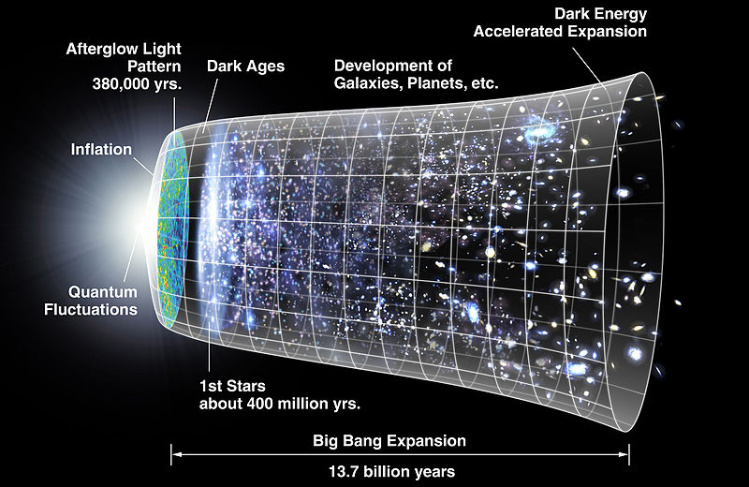
Decades of mathematical modeling and research have led cosmologists to a valid conclusion that our Universe started from a single point of infinite density and temperature called the singularity. The subsequent expansion of the cosmos allowed it to cool, which led to the formation of galaxies, stars, and other astronomical objects.
However, as we know, the standard Big Bang model has not gone unchallenged, and one such challenging theory was proposed by Christof Wetterich, a professor at Germany’s Heidelberg University.
Wetterich argued that the Universe we know today might have actually started as cold and sparse, awakened from a long freeze. Over time, the fundamental particles in the early Universe became heavier while the gravitational constant decreased.
Furthermore, he explained that if masses of the particles have been increasing, radiation from the early Universe could make space appear hotter and move away from each other even if it wasn’t the case.
The basic idea of Wetterich’s Slow Freeze cosmic model is that the Universe has no beginning and no future. Instead of a hot Big Bang, the theory advocates for a cold and slowly evolving Universe.
According to Wetterich, the theory explains density fluctuations in the early Universe (primordial fluctuations) and why our current cosmos is dominated by dark energy.
Read: All Interesting Facts About Black Holes and White Holes
2. Hindu Cosmology
Religion and science have been the best of enemies since at least the time of Copernicus and Galileo. There is perhaps no room for science when we talk about religion and vice-versa. However, there is one religion whose cosmological beliefs sit well with the current model of the Universe.
Creation theories in Hindu mythology are widely considered one of the most ancient and significant of all other religious counterparts.
Over the years, prominent physicists and cosmologists, including Carl Sagan and Niels Bohr, have admired Hindu cosmological beliefs for its close similarity with the timelines in the standard cosmological model of the Universe.
According to Hindu mythology, the Universe follows an infinite cyclic model. It means that our current Universe will be replaced by an endless number of universes. Each iteration of the Universe is divided into two phases, ‘Kalpa’ (or the day of Brahma) and ‘pralaya’ (the night of Brahma), and each is 4.32 billion years long.
According to Hindu mythology, the age of the Universe (8.64 billion years) is more than the currently estimated age of the solar system.
1. Steady State Universe
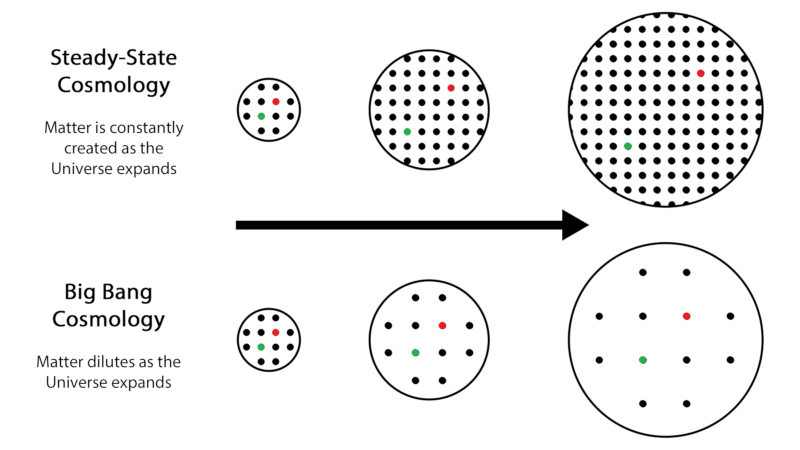
The Steady-State model asserts that the observable Universe remains the same at any place and time. In the Universe, which is forever expanding, matter is continuously created to fill the space.
The idea of the steady-state theory was first proposed in 1948 by cosmologists Hermann Bondi, Fred Hoyle, and Thomas Gold. It was derived from the perfect cosmological principle, which itself states that the Universe is the same no matter where you look, and it will always be the same.
According to the model, galaxies and other large astronomical bodies near us should appear similar to those that are far away. However, the Big Bang tells us that distant galaxies should look younger than those at close proximity (when observed from the Earth) since light takes much longer to reach us.
The Steady-State theory gained widespread popularity in the early and mid-20th century. However, by the 1960s, it was mostly discarded by the scientific community in favor of the Big Bang after the discovery of the cosmic microwave background.
Interestingly, according to a 1931 manuscript that was discovered by researchers in 2014, Albert Einstein was working on an alternative to the Big Bang theory. It was identical to Fred Hoyle’s Steady State model, proposing that the universe has expanded steadily. However, the idea was shortly abandoned by Einstein.
More to Know
How old is the universe.
The universe is nearly 14 billion years old (13.78 billion, to be exact). Scientists have reached this conclusion after extensive studies of the cosmic microwave background and analyzing data from the Plack Space Observatory, WMAP, and other space probes.
However, a team of researchers in 2019 calculated the age of the universe to be a couple of billion years younger than the age predicted by the Plank study. The team used the movement of galaxies and stars to estimate how fast the universe is expanding. A higher expansion rate means that the universe reached its current size faster, and thus, it must be younger.
To put an end to the discrepancy, an international team of astronomers analyzed the data from the Atacama Cosmology Telescope (ACT) in Chile in 2020 to find out the approximate age of the universe.
The team determined the age of the universe to be 13.77 billion years , give or take 40 million years, which is in line with the estimate from the Plank research team.
What is the Age of the Sun?
The estimated age of the Sun is about 4.56 billion years. How did they reach this number? Well, it is a combination of nuclear cosmochronology and simulations of the stellar evolution model.
8 Biggest Black Holes In The Universe | As Per Their Solar Masses
15 Brightest Stars In The Sky | Based On Apparent Magnitude
Different Types of Galaxies In The Universe
Varun Kumar
I am a professional technology and business research analyst with more than a decade of experience in the field. My main areas of expertise include software technologies, business strategies, competitive analysis, and staying up-to-date with market trends.
I hold a Master's degree in computer science from GGSIPU University. If you'd like to learn more about my latest projects and insights, please don't hesitate to reach out to me via email at [email protected] .
Related articles
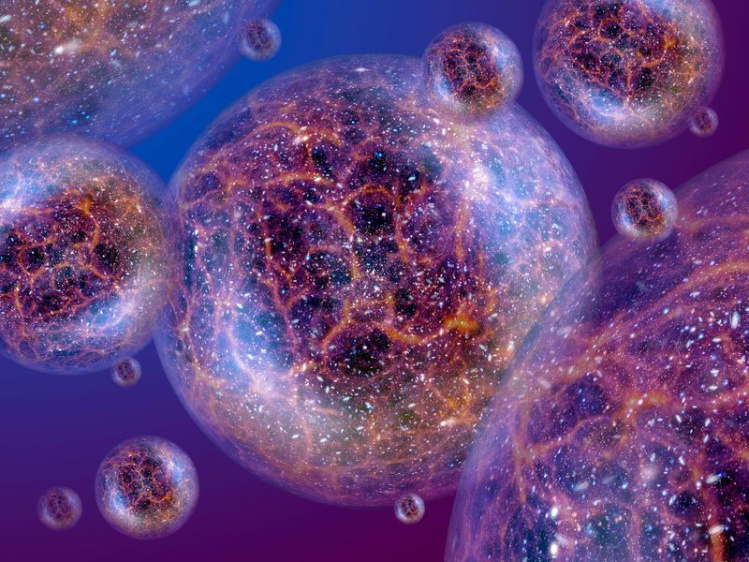
What’s Outside The Universe? Is Multiverse Theory True?

SpinLaunch Aims To A Use Large Catapult To Send Payloads Into Space
Leave a reply cancel reply.
In reference to the big bang, you never explain where all the material in the universe derived from. No matter what thoughtful possibility, Where did all the material derive from? It cannot come out of nothingness. Where is your explanation. What are you saying that I already said that? Is that any excuse for not being able to explain?
Its easier and more plausible that : (a) The universe has ALWAYS existed and WILL always exist. And that : (b) Is always subject to change dispite long periods of static in some regions. (c) contains an amount of energy which is infinite and dispite chemical interactions, remains the same. And (d) is composed of elements and particles, atoms and sub-atomic particles which can be known and are limited thou thier by-products may be unlimited. AND : (e) Life and living beings almost d i dont happen at all and so is unlikely to exist elsewhere at least anywhere near where we are. (f) 99.9 % of space is freezing cold and 0.001% is way hotter than any life form could ever tolerate. And percentages of infinite amounts are abstract. (g) the human mind and brain is the most complex thing in the known universe. (h) the universe is mainly harmless. (i) always take a towel !
Just came across your comment. I have searched for the words to extract your very questions, not really knowing just how to express such inquiries. I now have reference material to go forward. Yours. LOL.
Thanks for putting the words in my mouth. Brilliantly said.
do you have evidence about the theory of Steady State??
I’ve read it all, and I can see a preference for the big bank theory, in some version or other. What I cannot seem to find, in any writings, is a definition of the place at which the bang started, be it a point, line, or plane. If the universe is expanding, there are a lot of theories about it. But no one seems to be able to tell me from where?
If the Big Bang theory is correct and if the red-shift/ blue-shift theory is correct, they would lend credence to the idea of all expanding or outward flow of stars and galaxies all being red ( going away) vs blue ( coming in towards us). Under this scenario – trajectories at various galaxies and stars could be calculated to determine a point of origin of where the Big Bang started from. Is that spot then to be found void of all matter …? To date … blank spaces seem to hold much intrigue following Hubble’s highly successful 12 day synchronized stare into one of those many blank spaces, and most astronomers do not come away disappointed upon seeing developed plates of those blank spots. Every cubic light-year is chocked full of matter. So with this theory one could say …”bye – bye Big Bang theory”…
May 24, 2023
The Universe Began with a Bang, Not a Bounce, New Studies Find
New research pokes holes in the idea that the cosmos expanded and then contracted before beginning again
By James Riordon
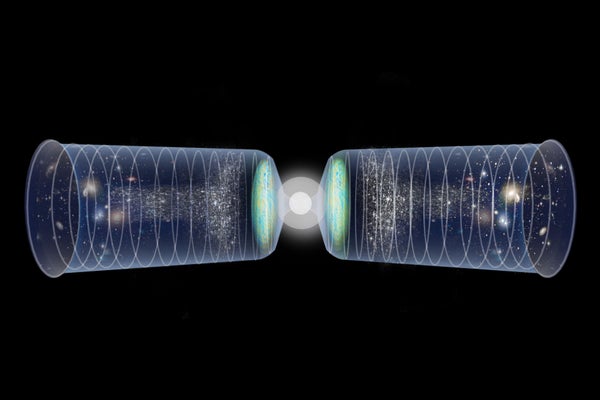
Science History Images/Alamy Stock Photo
How did the universe start? Did we begin with a big bang, or was there a bounce? Might the cosmos evolve in a cycle of expansion and collapse , over and over for all eternity? Now, in two papers, researchers have poked holes in different models of a so-called bouncing universe , suggesting the universe we see around us is probably a one-and-done proposition.
Bouncing universe proponents argue that our cosmos didn’t emerge on its own out of nothing. Instead, advocates claim, a prior universe shrunk in on itself and then regrew into the one we live in. This may have happened once or, according to some theories, an infinite number of times .
So which scenario is correct? The most widely accepted explanation for the history of the universe has it beginning with a big bang, followed by a period of rapid expansion known as cosmic inflation. According to that model, the glow left over from when the universe was hot and young, called the cosmic microwave background (CMB), should look pretty much the same no matter which direction you face. But data from the Planck space observatory, which mapped the CMB from 2009 to 2013, showed unexpected variations in the microwave radiation. They could be meaningless statistical fluctuations in the temperature of the universe, or they might be signs of something interesting going on.
On supporting science journalism
If you're enjoying this article, consider supporting our award-winning journalism by subscribing . By purchasing a subscription you are helping to ensure the future of impactful stories about the discoveries and ideas shaping our world today.
One possibility is that the CMB anomalies imply that the universe didn’t emerge out of nothing. Instead it came about after a prior universe collapsed and bounced back to create the space and time we live in today.
Bouncing universe models can explain these CMB patterns as well as account for lingering quibbles about the standard description of the universe’s origin and evolution. In particular, the big bang model of the universe begins with a singularity—a point that appeared out of nothing and contained the precursors of everything in the universe in a region so small that it had essentially no size at all. The idea is that the universe grew from the singularity and, after inflation, settled into the more gradually expanding universe we see today. But singularities are problematic because physics, and math itself, doesn’t make sense when everything is packed into a point that’s infinitely small. Many physicists prefer to avoid singularities.
One bouncing model that averts singularities and makes the CMB anomalies a little less anomalous is known as loop quantum cosmology (LQC). It relies on a bridge between classical physics and quantum mechanics known as loop quantum gravity, which posits that the force of gravity peters out at very small distances rather than increasing to infinity. “Cosmological models inspired by loop quantum gravity can solve some problems,” says University of Geneva cosmologist Ruth Durrer, “especially the singularity problem.” Durrer co-authored one of the two new studies on bouncing universes. In it, she and her colleagues looked for astronomical signs of such models .
In an LQC model, a precursor to our universe might have contracted under the force of gravity until it became extremely compact. Eventually quantum mechanics would have taken over. Instead of collapsing to a singularity, the universe would have started to expand again and may even have gone through an inflationary phase, as many cosmologists believe ours did.
If that happened, says physicist Ivan Agullo of Louisiana State University, it should have left a mark on the universe. Agullo, who was not affiliated with either of the recent analyses, has proposed that the mark would turn up in a feature in the CMB data known as the “bispectrum,” a measure of how different portions of the universe would have interacted in a bouncing scenario. The bispectrum would not be apparent in an image of the CMB, but it would show up in analyses of the frequencies in the ancient CMB microwaves.
“If observed,” Agullo says, the bispectrum “would serve as a smoking gun for the existence of a bounce instead of a bang.” Agullo’s group previously calculated the bispectrum as it would have appeared shortly after a cosmic bounce. Durrer and her colleagues took the calculation further, but when they compared it with the present-day Planck CMB data, there was no significant sign of a bispectrum imprint.
Although lots of other bouncing cosmos models may still be viable, the failure to find a significant bispectrum means that models that rely on LQC to deal with the anomalies in the CMB can be ruled out. It’s a sad result for Agullo, who had high hopes of finding concrete evidence of a bouncing universe. He still considers many bouncing universe models viable, however. And Paola Delgado, a cosmology Ph.D. candidate at Jagiellonian University in Poland, who worked on the new analysis that was co-authored by Durrer, says there’s one potential upside. “I heard for a long time that [attempts to merge quantum physics and cosmology] cannot be tested,” Delgado says. “I think it was really nice to see that for some classes of models, you still have some contact with observations.”
Ruling out signs of an LQC-driven cosmic bounce in Planck data means the CMB anomalies remain unexplained. But an even larger cosmic issue lingers: Did the universe have a beginning at all? As far as advocates of the big bang are concerned, it did. But that leaves us with the inscrutable singularity that started everything off.
Alternatively, according to theories of so-called cyclic cosmologies, the universe is immortal and is going through endless bounces. Although a bouncing universe may experience one or more cycles, a truly cyclic universe has no beginning and no end. It consists of a series of bounces that go back for an infinite number of cycles and will continue for an infinite number more. And because such a universe doesn’t have a beginning, there’s no big bang and no singularity.
The study that Durrer and Delgado co-authored doesn’t rule out immortal cyclic cosmologies. Plenty of theories describe such a bouncing universe in ways that would be difficult or impossible to distinguish from the “big bang plus inflation” model by looking at Planck CMB data.
But a critical flaw lurks in the idea of an eternally cycling universe, according to physicist William Kinney of the University at Buffalo, who co-authored the second recent analysis. That flaw is entropy, which builds up as a universe bounces. Often thought of as the amount of disorder in a system, entropy is related to the system’s amount of useful energy: the higher the entropy, the less energy available. If the universe increases in entropy and disorder with each bounce, the amount of usable energy available decreases each time. In that case, the cosmos would have had larger amounts of useful energy in earlier epochs. If you extrapolate back far enough, that implies a big bang–like beginning with an infinitely small amount of entropy, even for a universe that subsequently goes through cyclic bounces. (If you’re wondering how this scenario doesn’t violate the law of conservation of energy, we’re talking about available energy. Although the total amount of energy in the cosmos remains static, the amount that can do useful work decreases with increasing entropy.)
New cyclic models get around the problem, Kinney says, by requiring that the universe expands by a lot with each cycle. The expansion allows the universe to smooth out, dissipating the entropy before collapsing again. Although this explanation solves the entropy problem, Kinney and his University at Buffalo co-author Nina Stein calculated in their recent paper that the solution itself ensures that the universe is not immortal . “I feel like we’ve demonstrated something fundamental about the universe,” Kinney says, “which is that it probably had a beginning.” That implies a big bang occurred at some point, even if that event happened many bouncing universes ago, which in turn suggests that it took a singularity to get everything going in the first place.
Kinney’s paper is the latest in the debate over cyclic universes, but proponents of a universe without beginning or end have yet to respond in the scientific literature. Two leading proponents of a cyclic universe, astrophysicists Paul Steinhardt of Princeton University and Anna Ijjas of New York University, declined to comment for this article. If the history of the debate is any indication , though, we may soon hear of a work-around to counter Kinney’s analysis.
Some physicists say the Planck data only rule out a bounce under a loop quantum cosmology model that can explain away the CMB anomalies through the bispectrum, not other LQC bounce models that address anomalies using different mechanisms. Cosmologist Nelson Pinto-Neto of the Brazilian Center for Physics Research, who has studied bouncing and other cyclic models, agrees that LQC bounces that account for the CMB anomalies are likely off the table now, but he’s more sanguine on the question of a cyclic universe. “Existence is a fact. We are all here and now. Nonexistence is an abstraction of the human mind,” Nelson says. “This is the reason I think that a [cyclic universe], which has always existed, is simpler than one that has been created. However, as a scientist, I must be open to both possibilities.”
Editor’s Note (6/29/23): This article was edited after posting to better clarify scientits’ views on loop quantum cosmology bouncing universe models that account for the cosmic microwave background. The text was previously amended on June 1 to better clarify Ivan Agullo’s position on bouncing universe models.
Origin of the Universe
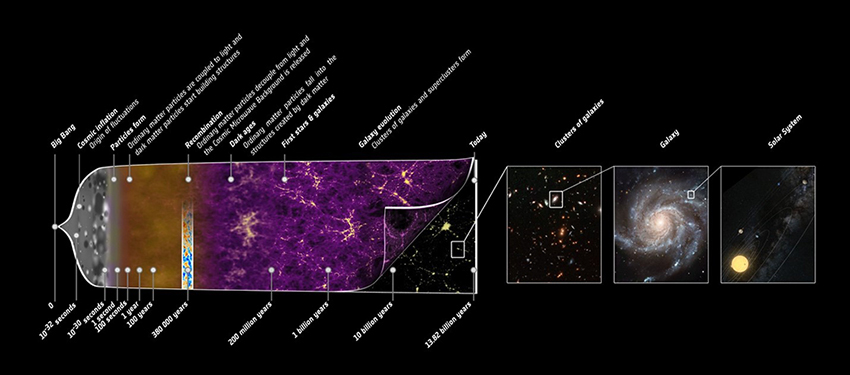
Cosmology researchers at JPL are investigating the origins, evolution, and composition of the universe, beginning with the inflationary era. All relevant areas of activity are pursued, including: 1) theoretical modeling of astrophysical and cosmological phenomena, 2) development of data analysis and science extraction enabling frameworks to support the ongoing and future space missions, and suborbital observing efforts, and 3) design and implementation of enabling detector technologies and instrumentation used to observe the universe on large scales and study distant objects.
Current Research Tasks
Cosmologists at JPL are studying the history of the Universe from the Big Bang, through reionization era, up to the present day. Microwave observations from the Planck spacecraft, and ground-based experiments such as BICEP2 , enabled determination of key parameters of the currently accepted Lambda-CDM cosmological model with unprecedented accuracy. The ongoing investigations in this area are searching for evidence of primordial gravitational waves from the Big Bang. The new technique of intensity mapping at frequencies from the infra-red to radio will attempt to reveal the large-scale structure of the Universe throughout its history. JPL cosmologists are also aiming to explain the nature of Dark Energy, a hypothetical cause for the accelerated expansion of the Universe in recent times. For this they use ground-based facilities such as the Prime Focus Spectrograph on the Subaru Telescope , and DESI , plan future missions such as Euclid or Roman Space Telescope (formerly known as WFIRST), and develop advanced technologies for future space-based astrophysics missions. These technologies could provide new capabilities for sensitive astronomical observations and gather a broad range of information in all areas including photometry, polarization and spectroscopy. JPL researchers are involved in developing tools to study a rich and diverse set of astrophysical data already obtained with a number of ground-based and space telescopes, including Hubble , Spitzer , Planck, and JUNO , as well as those coming in the future including Euclid, Roman, LISA and SPHEREx .
Selected Research Topics
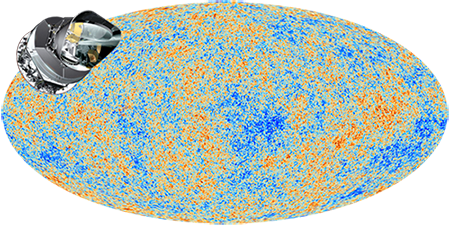
NASA had significant participation in the EuropeanSpace Agency's mission Planck . JPL made essential contributions to Planck, such as thermal design (V- grooves), sorption coolers, bolometers for High Frequency Instrument, and novel data analysis frameworks (e.g. HEALPix , Commander, FEBeCoP, and more). Planck was the third-generation space mission designed to observe the cosmic microwave background (CMB) with unprecedented angular resolution, sensitivity, and frequency coverage. Priceless legacy of Planck mission includes the most accurate and detailed full sky maps of both the CMB anisotropies, and many sources of astrophysical foreground emission. Planck's precise cosmological measurements allowed to answer important questions about the origin of the Universe and the formation of its large-scale structure. Analysis of Planck data has also revealed numerous star-forming clouds across the Milky Way, and has uncovered a previously invisible population of billion-year-old galaxies shrouded in dust.
Nancy Grace Roman Space Telescope
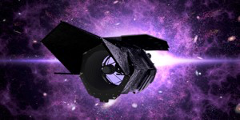
The Roman Space Telescope is a NASA observatory designed to unravel the secrets of dark energy and dark matter, search for and image exoplanets, and explore many topics in infrared astrophysics. The Telescope will have two instruments, the Wide Field Instrument, and the Coronagraph Instrument. The Wide Field Instrument (with a field of view that is 100 times greater than the Hubble infrared instrument) will enable the generation of new big pictures of the universe that willhelp astronomers explore some of the greatest mysteries of the cosmos, including why the expansion of the universe seems to be accelerating. The Roman Space Telescope will also feature a coronagraph technology demonstration instrument designed to directly image exoplanets by blocking out a star's light, allowing the much fainter planets to be observed.
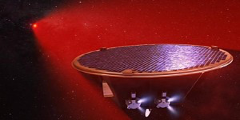
LISA is a space-based gravitational wave observatory building on the success of LISA Pathfinder and LIGO . Led by ESA, the LISA mission is a collaboration of ESA, NASA, and an international consortium of scientists. LISA will detect and accurately measure gravitational waves, tiny ripples in the fabric of space-time, from astronomical sources. LISA aims to measure gravitational waves directly by using laser interferometry: it will observe a passing gravitational wave directly by measuring the tiny changes in distance between freely falling proof masses inside the spacecraft with its high precision measurement system.
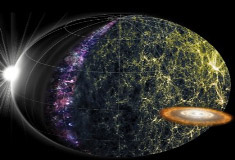
SPHEREx is a NASA Medium Class Explorers mission designed to constrain the physics of inflation by:
- studying its imprints on the three-dimensional large- scale distribution of matter
- tracing the history of galactic light production through a deep multi-band measurement of large-scale clustering investigating the abundance and composition of water and biogenic ices in the early phases of star and planetary disk formation
SPHEREx is the first all-sky spectral survey in the near IR: it will measure near-infrared spectra between 0.7 and 5 microns across the entire sky.
A Kansan's Guide to Science, page 3 of 4 Prev Page--History
The Origin of the Universe
What does science say about the origin of the universe.
Scientific evidence points to an origin sometime between 10 and 20 billion years ago. The Big Bang theory is universally accepted by those who do research on the development of the universe, galaxies, and stars as the cause of the origin of the universe. The Big Bang theory says that the universe has developed by expanding from a hot dense state with everything exploding away from everything else. What caused this explosion is not part of the Big Bang theory. It must be regarded as unknown at this time, although there are many ideas about the cause.
How do we know the universe is expanding?
The evidence indicates that as the Big Bang occurred, everything in the universe was an expanding mass of hot gas. As this mass of gas expanded, it cooled. Knots of matter formed that became the objects we see--including galaxies, stars, and planets such as our Earth. These objects continue to move away from one another even today, and, thus, our knowledge that the universe is expanding is based on observation. Evidence for the expanding universe comes from a phenomenon referred to as the redshift . When objects move apart rapidly, the light emitted by one and received by the other changes in a specific way. The light of an object moving rapidly shifts to the red end of the visible spectrum, and a redshift occurs. In the 1920's, scientists discovered that distant galaxies are moving away from us. Moreover, the farther away galaxies are, the faster the motion is relative to us and the greater the observed redshift. It happens that this kind of expansion is predicted by Einstein's general theory of relativity. This aspect of Einstein's theory has been tested by a number of experiments, and no test has been able to falsify the hypothesis. Over the years, many other scientific hypotheses have been introduced to explain the redshift without invoking an expanding universe. None of these hypotheses has a simple and direct connection with effects we can measure in the laboratory. It also is true that nearly all of them make other kinds of predictions about light that are not observed, so these hypotheses are no longer taken seriously.
Is there any other evidence for the Big Bang?
Three other major pieces of evidence indicate that the Big Bang occurred. The first is called the cosmic microwave background radiation (CMBR) , which is a weak form of radiation that comes from the sky and is energy that is left over from the very early universe (fig. 14). The CMBR was predicted during World War II, and in the 1960's it was detected for the first time. Since then, it has been measured and remeasured and now ranks as the most precise scientific measurement ever made. The second major piece of evidence concerns the fraction of various kinds of atoms in the universe. Scientists have calculated the amount of helium and other light atoms that should have been formed in the first few minutes after the Big Bang. The predictions agree remarkably well with what is observed. The third piece of evidence comes from our own eyes. Telescopes currently in use in Kansas and elsewhere allow us to see faraway galaxies as they appeared close to the time of the Big Bang because light takes so long to reach us from such distant objects. The observations continue to fit our interpretation of a universe that was very different early in its history. At the present time, we do not understand everything about the development of the universe. The work of science is not finished. We do not yet know how it started or what the dark matter is. We are, however, very confident that, in general, the Big Bang model is correct, and many physicists and astronomers are now working to fill in the details.
Fig. 14 --The cosmic microwave background is the afterglow radiation left over from the Big Bang. Shown here are cosmological fluctuations in the microwave background temperature made by the Cosmic Background Explorer (COBE) satellite (Spergel et al., 1999). Although extremely uniform all over the sky, tiny temperature variations can offer great insight into the origin, development, and initial structure of the universe.

Where did the Earth come from?
Most of the matter in the universe consists of such light elements as hydrogen and helium, plus an additional kind of unknown cold dark matter that is not yet well understood. Such heavier elements as carbon, oxygen, and silicon that are needed to form rocks and living organisms formed in earlier generations of stars that exploded, scattering the elements across the galaxy. These elements, sometimes referred to as ashes, were part of the matter that clumped together to form our solar system. Planets like our Earth are made primarily of the heavier elements. The Earth is known to be about 4.5 billion years old; the universe is at least three times older. A lot had to happen before the Earth could form!
What will happen to the universe in the future?
Scientists believe there are two possible scenarios. One is that the universe may collapse again into sort of a reverse of the Big Bang. The other is that it may continue to expand forever, eventually growing cold and dark. At present, the weight of evidence seems to indicate that it will expand forever. Our understanding of the nature of the cold dark matter, a subject being actively investigated by many scientists, may help us answer the question of the ultimate fate of the universe. If cold dark matter is sufficiently abundant, it could halt and possibly even reverse the universe's expansion.
Acknowledgments
We would like to thank Keith Miller, Charles Higginson, and Helen Alexander for comments on earlier versions of this booklet. Thanks go also to The Kansas Citizens for Science.
Bardack, D. , 1965, Anatomy and evolution of chirocentrid fishes: University of Kansas, Paleontological Contributions, v. 10, p. 1-87. [ Available Online ]
Brower, J.C., and Veinus, J. , 1981, Allometry in pterosaurs: University of Kansas, Paleontological Contributions, v. 105, p. 1-32. [ Available Online ]
Darwin, C., and Wallace, A.R. , 1858, On the tendency of species to form varieties; and on the perpetuation of varieties and species by natural means of selection: Journal of the Proceedings of the Linnean Society of London, Zoology, v. 3, p. 53-62.
Donovan, D.T., and Forsey, G.F. , 1973, Systematics of Lower Liassic Ammonitina: University of Kansas, Paleontological Contributions, v. 64, p. 1-24. [ Available Online ]
Eaton, T.H., Jr. , 1960, A new armored dinosaur from the Cretaceous of Kansas: University of Kansas, Paleontological Contributions, v. 8, p. 1-24. [ Available Online ]
Evans, C.S. , 1988, From sea to prairie--A primer of Kansas geology: Kansas Geological Survey, Educational Series 6, 60 p. [ Available Online ]
Martin, L. , 1984, A new hesperornithid and the relationships of the Mesozoic birds: Kansas Academy of Science, Transactions, v. 87, p. 141-150.
National Academy of Sciences , 1999, Science and creationism--A view from the National Academy of Sciences, 2nd ed.: Washington, D.C., National Academy Press, p. 24.
Peabody, F.E. , 1952, Petrolacosaurus kansensis Lane, a Pennsylvanian reptile from Kansas: University of Kansas, Paleontological Contributions, v. 1, p. 1-41. [ Available Online ]
Purves, W.K., Orians, G.H., Heller, H.C., and Sadava, D. , 1998, LIFE: The Science of Biology, 5th Edition: Sunderland, Massachusetts, Sinauer Associates, p. 438.
Reisz, R. , 1981, A diapsid reptile from the Pennsylvanian of Kansas: Museum of Natural History, University of Kansas, Special Publication, v. 7, p. 1-74.
Spergel, D.N., Hinshaw, G., and Bennett, C.L. , 1999, Introduction to Cosmology: NASA, [ Available Online ]
Zallinger, R.F. , 1989, The age of reptiles: Peabody Museum of Natural History, mural.
Adaptation --A trait that is particularly suited to an environment. It is the result of natural selection.
Big Bang Theory --The most supported explanation for the formation of the universe. All matter and energy in the universe came from a condensed hot mass that exploded and expanded in all directions.
Cambrian Explosion --An important event in the history of life that began around 540 million years ago and concluded around 510 million years ago. During this interval nearly all the major types of organisms now known on Earth, as well as several novel extinct types, appeared in the fossil record.
Cosmic Microwave Background Radiation (CMBR) --Radiation left over from the Big Bang. Fluctuation in the distribution of this energy is evidence of the structure of the universe right after the Big Bang.
Dark Matter --Invisible material in the universe that may mean that the universe is sufficiently heavy that it will not expand forever.
Ediacaran --A term used to describe the earliest known multicellular organisms, which appeared about 600 million years ago and largely went extinct just before the Cambrian explosion.
Evolution --Evolution is change through time. Biological evolution means change that has accompanied descent from a common ancestor.
Fossils --Any evidence of past life preserved in rocks.
Geologic Era --A long interval of geologic time recognized by the origination and extinction of a large number of plant and animal species. The boundaries usually correspond to times of major environmental change that lead to extinction and also spur evolutionary change. An example is the Mesozoic Era, when the large terrestrial dinosaurs lived. The average duration of an era is on the order of tens to hundreds of millions of years. We currently are in the Cenozoic Era, which began 65 million years ago.
Geologic Period --A long interval of geologic time, but shorter than an era, and again, defined by the origination or extinction of a large number of species. The number of species that evolve and go extinct at period boundaries, however, is less than at era boundaries. The boundaries also usually correspond to times of major environmental change, although not as major as those changes occurring at era boundaries. An example is the Cambrian Period, when animal life first appears in abundance in the fossil record. The average duration of a period is on the order of tens of millions of years. We currently are in the Quaternary Period which began 10,000 years ago.
Hominids --A group of primates that includes humans and several extinct species such as Homo erectus and the Neanderthals that all shared an upright posture.
Hypothesis --An explanation for observed phenomena. A hypothesis is used as a basis for further observations or experiments.
Law --A scientific statement that always applies, such as the law of gravity.
Macroevolution --Evolutionary changes that involve the production of new species. These occur over time scales of thousands of years. They are produced by a series of microevolutionary changes, but not all microevolutionary changes lead to macroevolution.
Microevolution --Evolutionary changes that occur within species. These occur over a range of time scales, from months to millions of years.
Natural Selection --Greater survival or reproductive success among some members of a population due to inherited traits that confer an advantage in the environment in which the population lived.
Radioactive Isotopes --Chemical elements that differ in their number of neutrons. For any radioactive isotope, the rate of decay into other elements is constant and therefore can be used to measure geologic time.
Red Shift --Light from an object that is moving away from an observer is shifted toward the red or longer wavelength end of the spectum relative to the light emitted at the source of the object. The fact that stars inside and outside of our galaxy predominantly show a red shift is evidence that the universe is expanding.
Species --A group of organisms that can interbreed with each other and produce fertile offspring. It is the fundamental unit of biological evolution.
Theory --An explanation for natural events that is based on a large number of observations and has been tested repeatedly.
Suggested Readings and Educational Resources
Publications on evolution.
Eldredge, Niles , 1999, The Pattern of Evolution: New York, W. H. Freeman.
Fortey, Richard , 1998, Life--A Natural History of the First Four Billion Years of Life on Earth: New York, Alfred P. Knopf.
Tattersall, Ian , 1998, Becoming Human: New York, Harcourt Brace.
Longair, Malcolm S. , 1996, Our Evolving Universe: New York, Cambridge University Press.
Gould, Stephen Jay , 1989, Wonderful Life--The Burgess Shale and the Nature of History: New York, W. W. Norton.
Dawkins, Richard , 1986, The Blind Watchmaker: New York, W. W. Norton.
Eldredge, Niles , 1985, Time Frames: Princeton, N. J., Princeton University Press.
Gould, Stephen Jay , 1977, Ever Since Darwin--Reflections in Natural History: New York, W. W. Norton.
Publications on the Nature of Science, the Relationship Between Science and Religion, and Creationism
Gould, Stephen Jay , 1999, Rock of Ages: New York, Harmony Books.
National Academy of Sciences , 1999, Science and Creationism, A View from the National Academy of Sciences, 2nd Ed.: Washington, D.C., National Academy Press.
Godfrey, Laurie , (editor), 1983, Scientists Confront Creationism: New York, W. W. Norton.
Eldredge, Niles , 2000, The Triumph of Evolution and the Failure of Creationism: New York, W. H. Freeman.
Scott, Eugenie C. , 2004, Evolution vs. Creationism: An Introduction: Westport, CT, Greenwood Press
Kansas Citizens for Science-- http://www.kcfs.org/
Kansas Geological Survey-- http://www.kgs.ku.edu/
NASA-- http://www.nasa.gov/index.html
National Academy of Sciences-- http://www.nasonline.org/
National Center for Science Education-- http://ncse.com/
Public Education Facilities
University of Kansas, Museum of Natural History and Biodiversity Research Center, Lawrence, Kansas [ http://naturalhistory.ku.edu/ ]
Sternberg Museum of Natural History, Hays, Kansas [ http://sternberg.fhsu.edu/ ]
Prev Page--History
The Origin of the Universe
- First Online: 19 May 2021
Cite this chapter
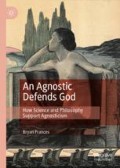
- Bryan Frances 2
115 Accesses
In Chap. 4 we saw impressive reasons for thinking that recent advances in physics fail to supply good reason to think that there had to have been some supernatural intelligence that designed the universe.
However, for many centuries people have looked to cosmology for evidence of God: something must have created the universe, and only a supremely powerful entity could have pulled it off. Their idea seems to have been bolstered by Big Bang cosmology, which says that the universe came into being about 14 billion years ago.
In this chapter I explain why philosophers generally agree that this “Cosmological Argument” for the existence of God is no good.
This is a preview of subscription content, log in via an institution to check access.
Access this chapter
- Available as PDF
- Read on any device
- Instant download
- Own it forever
- Available as EPUB and PDF
- Compact, lightweight edition
- Dispatched in 3 to 5 business days
- Free shipping worldwide - see info
- Durable hardcover edition
Tax calculation will be finalised at checkout
Purchases are for personal use only
Institutional subscriptions
As we’ll see below, some physicists insist that the Big Bang is not an “event”, considered as something that happens at a certain time.
Years earlier Einstein came up with the “Special Theory of Relativity”. GTR is a significant improvement on it.
This premise is not saying that there was a beginning but infinitely many years have passed since then. Instead, it’s saying that there was no beginning at all and for any finite number of years you can imagine, the universe’s past is older than that.
Author information
Authors and affiliations.
Department of Cognitive Sciences, United Arab Emirates University, Al Ain, Abu Dhabi, United Arab Emirates
Bryan Frances
You can also search for this author in PubMed Google Scholar
Rights and permissions
Reprints and permissions
Copyright information
© 2021 The Author(s), under exclusive license to Springer Nature Switzerland AG
About this chapter
Frances, B. (2021). The Origin of the Universe. In: An Agnostic Defends God. Palgrave Macmillan, Cham. https://doi.org/10.1007/978-3-030-73331-5_5
Download citation
DOI : https://doi.org/10.1007/978-3-030-73331-5_5
Published : 19 May 2021
Publisher Name : Palgrave Macmillan, Cham
Print ISBN : 978-3-030-73330-8
Online ISBN : 978-3-030-73331-5
eBook Packages : Religion and Philosophy Philosophy and Religion (R0)
Share this chapter
Anyone you share the following link with will be able to read this content:
Sorry, a shareable link is not currently available for this article.
Provided by the Springer Nature SharedIt content-sharing initiative
- Publish with us
Policies and ethics
- Find a journal
- Track your research

Science and Creationism: A View from the National Academy of Sciences, Second Edition (1999)
Chapter: the origin of the universe, earth, and life, the origin of the universe, earth, and life.
The term "evolution" usually refers to the biological evolution of living things. But the processes by which planets, stars, galaxies, and the universe form and change over time are also types of "evolution." In all of these cases there is change over time, although the processes involved are quite different.
In the late 1920s the American astronomer Edwin Hubble made a very interesting and important discovery. Hubble made observations that he interpreted as showing that distant stars and galaxies are receding from Earth in every direction. Moreover, the velocities of recession increase in proportion with distance, a discovery that has been confirmed by numerous and repeated measurements since Hubble's time. The implication of these findings is that the universe is expanding.
Hubble's hypothesis of an expanding universe leads to certain deductions. One is that the universe was more condensed at a previous time. From this deduction came the suggestion that all the currently observed matter and energy in the universe were initially condensed in a very small and infinitely hot mass. A huge explosion, known as the Big Bang, then sent matter and energy expanding in all directions.

This Big Bang hypothesis led to more testable deductions. One such deduction was that the temperature in deep space today should be several degrees above absolute zero. Observations showed this deduction to be correct. In fact, the Cosmic Microwave Background Explorer (COBE) satellite launched in 1991 confirmed that the background radiation field has exactly the spectrum predicted by a Big Bang origin for the universe.
As the universe expanded, according to current scientific understanding, matter collected into clouds that began to condense and rotate, forming the forerunners of galaxies. Within galaxies, including our own Milky Way galaxy, changes in pressure caused gas and dust to form distinct clouds. In some of these clouds, where there was sufficient mass and the right forces, gravitational attraction caused the cloud to collapse. If the mass of material in the cloud was sufficiently compressed, nuclear reactions began and a star was born.
Some proportion of stars, including our sun, formed in the middle of a flattened spinning disk of material. In the case of our sun, the gas and dust within this disk collided and aggregated into small grains, and the grains formed into larger bodies called planetesimals ("very small planets"), some of which reached diameters of several hundred kilometers. In successive stages these planetesimals coalesced into the nine planets and their numerous satellites. The rocky planets, including Earth, were near the sun, and the gaseous planets were in more distant orbits.
The ages of the universe, our galaxy, the solar system, and Earth can be estimated using modem scientific methods. The age of the universe can be derived from the observed relationship between the velocities of and the distances separating the galaxies. The velocities of distant galaxies can be measured very accurately, but the measurement of distances is more uncertain. Over the past few decades, measurements of the Hubble expansion have led to estimated ages for the universe of between 7 billion and 20 billion years, with the most recent and best measurements within the range of 10 billion to 15 billion years.

A disk of dust and gas, appearing as a dark band in this Hubble Space Telescope photograph, bisects a glowing nebula around a very young star in the constellation Taurus. Similar disks can be seen around other nearby stars and are thought to provide the raw material for planets.
The age of the Milky Way galaxy has been calculated in two ways. One involves studying the observed stages of evolution of different-sized stars in globular clusters. Globular clusters occur in a faint halo surrounding the center of the Galaxy, with each cluster containing from a hundred thousand to a million stars. The very low amounts of elements heavier than hydrogen and helium in these stars indicate that they must have formed early in the history of the Galaxy, before large amounts of heavy elements were created inside the initial generations of stars and later distributed into the interstellar medium through supernova explosions (the Big Bang itself created primarily hydrogen and helium atoms). Estimates of the ages of the stars in globular clusters fall within the range of 11 billion to 16 billion years.
A second method for estimating the age of our galaxy is based on the present abundances of several long-lived radioactive elements in the solar system. Their abundances are set by their rates of production and distribution through exploding
supernovas. According to these calculations, the age of our galaxy is between 9 billion and 16 billion years. Thus, both ways of estimating the age of the Milky Way galaxy agree with each other, and they also are consistent with the independently derived estimate for the age of the universe.
Radioactive elements occurring naturally in rocks and minerals also provide a means of estimating the age of the solar system and Earth. Several of these elements decay with half lives between 700 million and more than 100 billion years (the half life of an element is the time it takes for half of the element to decay radioactively into another element). Using these time-keepers, it is calculated that meteorites, which are fragments of asteroids, formed between 4.53 billion and 4.58 billion years ago (asteroids are small "planetoids" that revolve around the sun and are remnants of the solar nebula that gave rise to the sun and planets). The same radioactive time-keepers applied to the three oldest lunar samples returned to Earth by the Apollo astronauts yield ages between 4.4 billion and 4.5 billion years, providing minimum estimates for the time since the formation of the moon.
The oldest known rocks on Earth occur in northwestern Canada (3.96 billion years), but well-studied rocks nearly as old are also found in other parts of the world. In Western Australia, zircon crystals encased within younger rocks have ages as old as 4.3 billion years, making these tiny crystals the oldest materials so far found on Earth.
The best estimates of Earth's age are obtained by calculating the time required for development of the observed lead isotopes in Earth's oldest lead ores. These estimates yield 4.54 billion years as the age of Earth and of meteorites, and hence of the solar system.
The origins of life cannot be dated as precisely, but there is evidence that bacteria-like organisms lived on Earth 3.5 billion years ago, and they may have existed even earlier, when the first solid crust formed, almost 4 billion years ago. These early organisms must have been simpler than the organisms living today. Furthermore, before the earliest organisms there must have been structures that one would not call "alive" but that are now components of living things. Today, all living organisms store and transmit hereditary information using two kinds of molecules: DNA and RNA. Each of these molecules is in turn composed of four kinds of subunits known as nucleotides. The sequences of nucleotides in particular lengths of DNA or RNA, known as genes, direct the construction of molecules known as proteins, which in turn catalyze biochemical reactions, provide structural components for organisms, and perform many of the other functions on which life depends. Proteins consist of chains of subunits known as amino acids. The sequence of nucleotides in DNA and RNA therefore determines the sequence of amino acids in proteins; this is a central mechanism in all of biology.
Experiments conducted under conditions intended to resemble those present on primitive Earth have resulted in the production of some of the chemical components of proteins, DNA, and RNA. Some of these molecules also have been detected in meteorites from outer space and in interstellar space by astronomers using radio-telescopes. Scientists have concluded that the "building blocks of life" could have been available early in Earth's history.
An important new research avenue has opened with the discovery that certain molecules made of RNA, called ribozymes, can act as catalysts in modem cells. It previously had been thought that only proteins could serve as the catalysts required to carry out specific biochemical functions. Thus, in the early prebiotic world, RNA molecules could have been "autocatalytic"—that is, they could have replicated themselves well before there were any protein catalysts (called enzymes).

Laboratory experiments demonstrate that replicating autocatalytic RNA molecules undergo spontaneous changes and that the variants of RNA molecules with the greatest autocatalytic activity come to prevail in their environments. Some scientists favor the hypothesis that there was an early "RNA world," and they are testing models that lead from RNA to the synthesis of simple DNA and protein molecules. These assemblages of molecules eventually could have become packaged within membranes, thus making up "protocells"—early versions of very simple cells.
For those who are studying the origin of life, the question is no longer whether life could have originated by chemical processes involving nonbiological components. The question instead has become which of many pathways might have been followed to produce the first cells.
Will we ever be able to identify the path of chemical evolution that succeeded in initiating life on Earth? Scientists are designing experiments and speculating about how early Earth could have provided a hospitable site for the segregation of
molecules in units that might have been the first living systems. The recent speculation includes the possibility that the first living cells might have arisen on Mars, seeding Earth via the many meteorites that are known to travel from Mars to our planet.
Of course, even if a living cell were to be made in the laboratory, it would not prove that nature followed the same pathway billions of years ago. But it is the job of science to provide plausible natural explanations for natural phenomena. The study of the origin of life is a very active research area in which important progress is being made, although the consensus among scientists is that none of the current hypotheses has thus far been confirmed. The history of science shows that seemingly intractable problems like this one may become amenable to solution later, as a result of advances in theory, instrumentation, or the discovery of new facts.
Creationist Views of the Origin of the Universe, Earth, and Life
Many religious persons, including many scientists, hold that God created the universe and the various processes driving physical and biological evolution and that these processes then resulted in the creation of galaxies, our solar system, and life on Earth. This belief, which sometimes is termed "theistic evolution," is not in disagreement with scientific explanations of evolution. Indeed, it reflects the remarkable and inspiring character of the physical universe revealed by cosmology, paleontology, molecular biology, and many other scientific disciplines.
The advocates of "creation science" hold a variety of viewpoints. Some claim that Earth and the universe are relatively young, perhaps only 6,000 to 10,000 years old. These individuals often believe that the present physical form of Earth can be explained by "catastrophism," including a worldwide flood, and that all living things (including humans) were created miraculously, essentially in the forms we now find them.
Other advocates of creation science are willing to accept that Earth, the planets, and the stars may have existed for millions of years. But they argue that the various types of organisms, and especially humans, could only have come about with supernatural intervention, because they show "intelligent design."
In this booklet, both these "Young Earth" and "Old Earth" views are referred to as "creationism" or "special creation."
There are no valid scientific data or calculations to substantiate the belief that Earth was created just a few thousand years ago. This document has summarized the vast amount of evidence for the great age of the universe, our galaxy, the solar system, and Earth from astronomy, astrophysics, nuclear physics, geology, geochemistry, and geophysics. Independent scientific methods consistently give an age for Earth and the solar system of about 5 billion years, and an age for our galaxy and the universe that is two to three times greater. These conclusions make the origin of the universe as a whole intelligible, lend coherence to many different branches of science, and form the core conclusions of a remarkable body of knowledge about the origins and behavior of the physical world.
Nor is there any evidence that the entire geological record, with its orderly succession of fossils, is the product of a single universal flood that occurred a few thousand years ago, lasted a little longer than a year, and covered the highest mountains to a depth of several meters. On the contrary, intertidal and terrestrial deposits demonstrate that at no recorded time in the past has the entire planet been under water. Moreover, a universal flood of sufficient magnitude to form the sedimentary rocks seen today, which together are many kilometers thick, would require a volume of water far greater than has ever existed on and in Earth, at least since the formation of the first known solid crust about 4 billion years ago. The belief that Earth's sediments, with their fossils, were deposited in an orderly sequence in a year's time defies all geological observations and physical principles concerning sedimentation rates and possible quantities of suspended solid matter.
Geologists have constructed a detailed history of sediment deposition that links particular bodies of rock in the crust of Earth to particular environments and processes. If petroleum geologists could find more oil and gas by interpreting the record of sedimentary rocks as having resulted from a single flood, they would certainly favor the idea of such a flood, but they do not. Instead, these practical workers agree with academic geologists about the nature of depositional environments and geological time. Petroleum geologists have been pioneers in the recognition of fossil deposits that were formed over millions of years in such environments as meandering rivers, deltas, sandy barrier beaches, and coral reefs.
The example of petroleum geology demonstrates one of the great strengths of science. By using knowledge of the natural world to predict the consequences of our actions, science makes it possible to solve problems and create opportunities using technology. The detailed knowledge required to sustain our civilization could only have been derived through scientific investigation.
The arguments of creationists are not driven by evidence that can be observed in the natural world. Special creation or supernatural intervention is not subjectable to meaningful tests, which require predicting plausible results and then checking these results through observation and experimentation. Indeed, claims of "special creation" reverse the scientific process. The explanation is seen as unalterable, and evidence is sought only to support a particular conclusion by whatever means possible.
While the mechanisms of evolution are still under investigation, scientists universally accept that the cosmos, our planet, and life evolved and continue to evolve. Yet the teaching of evolution to schoolchildren is still contentious.
In Science and Creationism , The National Academy of Sciences states unequivocally that creationism has no place in any science curriculum at any level.
Briefly and clearly, this booklet explores the nature of science, reviews the evidence for the origin of the universe and earth, and explains the current scientific understanding of biological evolution. This edition includes new insights from astronomy and molecular biology.
Attractive in presentation and authoritative in content, Science and Creationism will be useful to anyone concerned about America's scientific literacy: education policymakers, school boards and administrators, curriculum designers, librarians, teachers, parents, and students.
READ FREE ONLINE
Welcome to OpenBook!
You're looking at OpenBook, NAP.edu's online reading room since 1999. Based on feedback from you, our users, we've made some improvements that make it easier than ever to read thousands of publications on our website.
Do you want to take a quick tour of the OpenBook's features?
Show this book's table of contents , where you can jump to any chapter by name.
...or use these buttons to go back to the previous chapter or skip to the next one.
Jump up to the previous page or down to the next one. Also, you can type in a page number and press Enter to go directly to that page in the book.
Switch between the Original Pages , where you can read the report as it appeared in print, and Text Pages for the web version, where you can highlight and search the text.
To search the entire text of this book, type in your search term here and press Enter .
Share a link to this book page on your preferred social network or via email.
View our suggested citation for this chapter.
Ready to take your reading offline? Click here to buy this book in print or download it as a free PDF, if available.
Get Email Updates
Do you enjoy reading reports from the Academies online for free ? Sign up for email notifications and we'll let you know about new publications in your areas of interest when they're released.
Watch for falling links !
Text of `origin of the universe' by s.w. hawking.

Virginia Gazette Opinion | World Focus: The origin of the universe
Share this:.
- Click to share on Facebook (Opens in new window)
- Click to share on X (Opens in new window)

- Virginia Gazette Public Notices
- Gazette E-paper
Virginia Gazette
Virginia gazette opinion.

As part of the Sunday Lecture Series at the Temple Beth El of Williamsburg, a recent program titled “The Origin of the Universe: A Dialogue on Religion and Science” was presented by Rabbi David Katz, the spiritual leader of the temple, and Joel Levine, a senior scientist at NASA for 41 years. Levine currently serves as a research professor in the Applied Science department at William & Mary.
Rabbi Katz explained that the Torah’s story of creation in chapters one and two implies these are actually two different versions of the story of creation.
In Chapter 1’s story, male and female humans are created at the same time, on day six, after all other life forms have been created. In Chapter 2’s story, only a male human is being created. Later, God creates a helpmate for this man out of his rib.
“These are two different and separate stories,” Katz said. “It is made clear by the parallel yet different Hebrew used in verse 1:1 and then 2:4. This tells us that the Torah did not consider its stories to be correct and authoritative, but instead having multiple versions.”
Katz continued: “Multiple versions of the same story means that the Torah and its authors did not know for certain how the universe was created, but instead they speculated by sharing multiple stories about this.”
Katz, a student of the Torah, believes that the Torah not knowing for sure means that there is a point past which even our ancient religious leaders could only guess about what happened — which is similar to what science teaches us.
The Webb telescope can see back so far, Katz noted. “We can only speculate about what happened before what we can see. I believe this is also what the Torah is trying to tell us.
Levine introduced his lecture by quoting Albert Einstein, Nobel Prize laureate in physics, who stated, “Science without religion is lame. Religion without science is blind.”
Levine’s lecture was illustrated with spectacular new photographs of the universe obtained with the recently launched NASA James Webb Space Telescope, the most powerful telescope ever built. It is a hundred times more powerful than the earlier Hubble Space Telescope. The JWST has already looked back in time to see the universe 13.3 billion years ago. The JWST has the power to see back to the very early history of the universe, perhaps even back to the time of the Big Bang, which astronomers believe took place 13.8 billion years ago.
I asked Levine, how do the new discoveries of what happened billions of years ago in outer space and what he described in his lecture affect our lives on Earth today?
“They have no impact on us today,” Levine said. “But astronomers and other scientists have great interest in the new discoveries of the James Webb Space Telescope. The JWST is revising our understanding about the origin, early history and evolution of the universe.”
Just as in the past, the quest for new discoveries opens new paths to technological innovations that are fueling economic progress.
Levine is fond of saying: “All that money NASA is spending on research is not spent in outer space, but here, in America, to help stimulate the economy and create American jobs.”
Frank Shatz is a Williamsburg resident. He is the author of “Reports from a Distant Place,” the compilation of his selected columns. The book is available at Bruton Parish Shop and Amazon.com.
More in Virginia Gazette Opinion

Virginia Gazette Opinion | Commentary: The U.S. Supreme Court is legitimate

SUBSCRIBER ONLY
Virginia gazette opinion | letters to the gazette.

Virginia Gazette Opinion | World Focus: Don’t bet against America

Virginia Gazette Opinion | Commentary: Military flight crews deserve better
Trending nationally.
- Questions could linger after video of fatal police shooting of Dexter Reed roils Chicago
- Federal safety investigators home in on electronics of cargo ship that destroyed Baltimore’s Key Bridge
- CT private school goes co-ed for first time, opening to girls. ‘The time seems right.’
- Former Knicks guard Nate Robinson needs kidney transplant, doesn’t ‘have long to live’
- Trump is about to go on trial in New York. Here’s what to expect

IMAGES
VIDEO
COMMENTS
The most popular theory of our universe's origin centers on a cosmic cataclysm unmatched in all of history—the big bang. Learn about the big bang theory and how our universe got started.
Origin of the Universe. Cosmologists are closing in on the ultimate processes that created and shaped the universe. By Michael S. Turner. May 2013 Issue. The Sciences. The universe is big in both ...
Figure 2.1.2 2.1. 2: Timeline of expansion of the universe. The mysterious details of events prior to and during the origin of the universe are subject to great scientific debate. The prevailing idea about how the universe was created is called the big-bang theory. Although the ideas behind the big-bang theory feel almost mystical, they are ...
Origins of the Universe 101. How old is the universe, and how did it begin? Throughout history, countless myths and scientific theories have tried to explain the universe's origins. The most widely accepted explanation is the big bang theory. Learn about the explosion that started it all and how the universe grew from the size of an atom to ...
big-bang model, widely held theory of the evolution of the universe. Its essential feature is the emergence of the universe from a state of extremely high temperature and density —the so-called big bang that occurred 13.8 billion years ago. Although this type of universe was proposed by Russian mathematician Aleksandr Friedmann and Belgian ...
Some 15 billion years ago the universe emerged from a hot, dense sea of matter and energy. As the cosmos expanded and cooled, it spawned galaxies, stars, planets and life. By P. James E. Peebles ...
Figure 8.1.1 8.1. 1: Timeline of expansion of the universe. The mysterious details of events prior to and during the origin of the universe are subject to great scientific debate. The prevailing idea about how the universe was created is called the big-bang theory. Although the ideas behind the big-bang theory feel almost mystical, they are ...
The Big Bang is a physical theory that describes how the universe expanded from an initial state of high density and temperature. It was first proposed in 1927 by Roman Catholic priest and physicist Georges Lemaître.Various cosmological models of the Big Bang explain the evolution of the observable universe from the earliest known periods through its subsequent large-scale form.
The Universe's History The origin, evolution, and nature of the universe have fascinated and confounded humankind for centuries. New ideas and major discoveries made during the 20th century transformed cosmology - the term for the way we conceptualize and study the universe - although much remains unknown. Here is the history of the universe according […]
The widely accepted theory for the origin and evolution of the universe is the Big Bang model, which states that the universe began as an incredibly hot, dense point roughly 13.7 billion years ago.
Hubble's discovery was the first observational support for Georges Lemaître's Big Bang theory of the universe, proposed in 1927. Lemaître proposed that the universe expanded explosively from an extremely dense and hot state, and continues to expand today. Subsequent calculations have dated this Big Bang to approximately 13.7 billion years ...
The Big Bang: Origins of our Universe. The Big Bang is the best-supported scientific theory for how the universe was created. 13.7 billion years ago there was nothing and nowhere. Everything that ever existed was contained in a subatomic particle that was billions of times smaller than an atom.
Step 2: The universe's first growth spurt. Step 3: Too hot to shine. Step 4: Let there be light. Step 5: Emerging from the cosmic dark ages. Step 6: More stars and more galaxies. Step 7: Birth of ...
The universe is all of space and time and their contents. It comprises all of existence, any fundamental interaction, physical process and physical constant, and therefore all forms of energy and matter, and the structures they form, from sub-atomic particles to entire galaxies.Space and time, according to the prevailing cosmological theory of the Big Bang, emerged together 13.787 ± 0.020 ...
2. Hindu Cosmology. Religion and science have been the best of enemies since at least the time of Copernicus and Galileo. There is perhaps no room for science when we talk about religion and vice-versa. However, there is one religion whose cosmological beliefs sit well with the current model of the Universe.
The most widely accepted explanation for the history of the universe has it beginning with a big bang, followed by a period of rapid expansion known as cosmic inflation. According to that model ...
Cosmologists at JPL are studying the history of the Universe from the Big Bang, through reionization era, up to the present day. Microwave observations from the Planck spacecraft, and ground-based experiments such as BICEP2, enabled determination of key parameters of the currently accepted Lambda-CDM cosmological model with unprecedented accuracy.
The Origin of the Universe What does science say about the origin of the universe? Scientific evidence points to an origin sometime between 10 and 20 billion years ago. The Big Bang theory is universally accepted by those who do research on the development of the universe, galaxies, and stars as the cause of the origin of the universe.
The universe had a beginning: there was a first event. (b) If the universe had a beginning, then the first event must have been caused to happen by something; at least, this is highly probable. (c) Whatever caused the beginning of the physical universe must be God; at least this is highly probable. (d) Thus, there is excellent evidence that God ...
hypothesis that the universe sprang into being five minutes ago with all the appropriate appearances of age for a universe billions of years old. Thomas Morris (1987) points out that the problem with Russell's hypothesis is that. it would require us to reject the truth of the vast majority of all the empirical.
The Origin of the Universe, Earth, and Life. The term "evolution" usually refers to the biological evolution of living things. But the processes by which planets, stars, galaxies, and the universe form and change over time are also types of "evolution." ... Hubble's hypothesis of an expanding universe leads to certain deductions. One is that ...
The implication of these findings is that the universe is expanding. Hubble's hypothesis of an expanding universe leads to certain deductions. One is that the universe was more condensed at a previous time. ... These conclusions make the origin of the universe as a whole intelligible, lend coherence to many different branches of science, and ...
The problem of the origin of the universe, is a bit like the old question: Which came first, the chicken, or the egg. In other words, what agency created the universe. ... either theory could account for such a universe. Indeed, in 1781, the philosopher, Immanuel Kant, wrote a monumental, and very obscure work, The Critique of Pure Reason. In ...
The JWST is revising our understanding about the origin, early history and evolution of the universe.". Just as in the past, the quest for new discoveries opens new paths to technological ...
The steady-state theory of the universe was put forth in 1948 by British scientists Sir Hermann Bondi, Thomas Gold, and Sir Fred Hoyle as an alternative to the then-new Big Bang model. Where Big ...